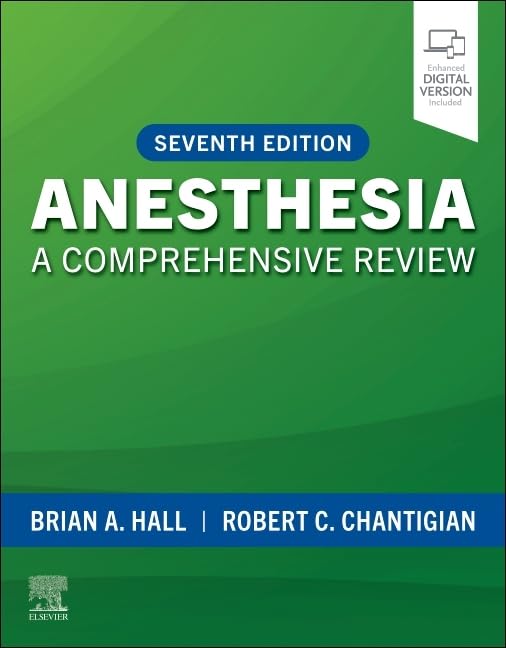
Edition 7 (2026)
Brian Hall, Robert Chantigian
Prepare for success on high-stakes exams with Anesthesia: A Comprehensive Review, 7th Edition! With complete, up-to-date coverage of everything from basic science through current clinical practice, this fully revised review tool contains more than 1,000 board review-style questions in a multiple choice format. You’ll reinforce your current knowledge, identify areas that require more study, and improve your long-term retention of the material―all while preparing for certification and re-certification examinations as well as clinical practice.
Contains more than 1,000 fully updated multiple choice questions (100+ new to this edition) with answers and supporting explanations.
Mirrors the ABA written exam content and format, with challenging board review questions and answers covering the latest discoveries and techniques in physics, biochemistry, and anesthesia equipment; the newest drugs and drug categories; and the most recent information on all anesthesia subspecialties.
Features new questions on technology and devices, geriatric patients, demographic data, blood banking, transfusion, anticoagulants and anticoagulant reversal drugs, as well as new questions comparing medications/drugs with similar pharmacodynamic effects.
Offers discussions after each question, along with corresponding page references to major anesthesia texts so it’s easy to find more information on any subject.
Allows you to test interactively online with a scoreboard and notes field, and features a new, online-only chapter featuring additional open-ended questions.
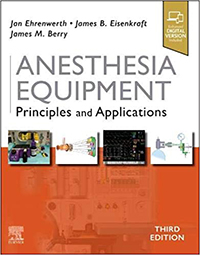
Edition 3 (2020)
Jan Ehrenwert, James Eisenkraft, James Berry
Offering highly visual, easy-to-read coverage of the full range of anesthesia equipment in use today, this authoritative reference is your go-to text for objective, informed answers to ensure optimal patient safety. Anesthesia Equipment, 3rd Edition, provides detailed information on the intricate workings of each device or workstation, keeping you fully up to date and helping you meet both equipment and patient care challenges.
Remains unequalled in both depth and breadth of coverage, offering readable, concise guidance on all aspects of today’s anesthesia machines and equipment.
Details the latest machines, vaporizers, ventilators, breathing systems, vigilance, ergonomics, and simulation.
Improves your understanding of the physical principles of equipment, the rationale for its use, delivery systems for inhalational anesthesia, systems monitoring, hazards and safety features, maintenance and quality assurance, special situations/equipment for non-routine adult anesthesia, and future directions for the field.
Includes ASA Practice Parameters for care, and helps you ensure patient safety with detailed advice on risk management and medicolegal implications of equipment use.
Highlights the text with hundreds of full-color line drawings and photographs, graphs, and charts.
Enhanced eBook version included with purchase. Your enhanced eBook allows you to access all of the text, figures, and references from the book on a variety of devices.
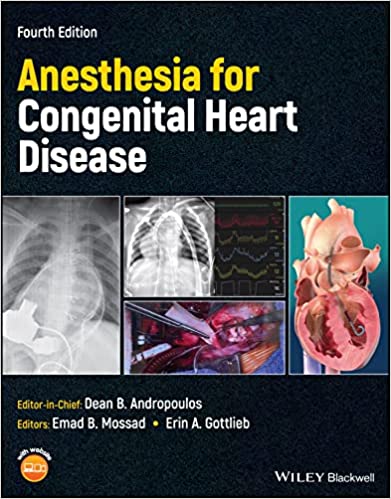
Edition 4 (2023)
Dean Andropoulos, Emad Mossad, Erin Gottlieb
An Extensive Reference Work Detailing the Procedures, Knowledge, and Approaches in Anesthesia for Congenital Heart Disease
In the 4th edition of Anesthesia for Congenital Heart Disease, a distinguished group of expert authors in congenital heart disease from all over the world provide a thorough, comprehensive and fully updated overview of the specifics of congenital heart disease (CHD), and the intricacies involved with administering anesthetic care to patients who suffer from the myriad of lesions encompassed by CHD.
In the seven years since the 3rd Edition of Anesthesia for Congenital Heart Disease was published, an explosion of new procedures, approaches, and patients eligible for anesthetic care has occurred. The goal of Anesthesia for Congenital Heart Disease, Fourth Edition is to help readers understand all of the recent advancements and developments in the field while also imparting a foundation of essential historical knowledge. The book contains new chapters that reflect exciting new approaches in this rapidly changing field, and also includes:
Updated information in the chapter Adult Congenital Heart Disease and Mechanical Support of the Circulation, reflecting the increasing prominence of these patients in CHD care
New chapters on Informatics and Artificial Intelligence, Genetic Syndromes, Point of Care Ultrasound, and Cardiopulmonary Resuscitation in Congenital Heart Disease
Thorough updates of all chapters with many new figures and tables, and hundreds of new recent references provide up to date information
Anesthesia for Congenital Heart Disease, Fourth Edition serves as a thorough and in-depth reference work and is an essential resource for practitioners providing perioperative care to CHD patients.
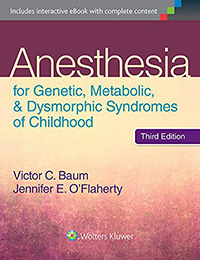
Edition 3 (2015)
Victor Baum, Jennifer O'Flaherty
Using a quick-reference, encyclopedic format, Anesthesia for Genetic, Metabolic, and Dysmorphic Syndromes of Childhood, 3rd Edition, presents the anesthetic implications of a plethora of distinct syndromes, with up-to-date information, complete and current bibliographies, and more than 140 clinical photographs. You’ll find practical information on common and uncommon manifestations in the major anatomic areas, as well as what you need to know for safe and effective anesthesia of both children and adults.
Key Features:
Presents each syndrome in an easy-to-follow format: name, synonym(s), and common and uncommon manifestations in each organ system, followed by anesthetic considerations, including which syndromes have no anesthetic implications.
Lists syndromes and synonyms alphabetically, and cross-references synonyms for quick look-up.
Incorporates an overview of the pathology and relevant clinical findings for each syndrome, and highlights considerations in perioperative management.
Features a helpful glossary at the beginning of the book, as well as diagrams that review pertinent biochemical pathways.
Now with the print edition, enjoy the bundled interactive eBook edition, offering tablet, smartphone, or online access to:
Complete content with enhanced navigation
Powerful search tools and smart navigation cross-links that pull results from content in the book, your notes, and even the web
Cross-linked pages, references, and more for easy navigation
Highlighting tool for easier reference of key content throughout the text
Ability to take and share notes with friends and colleagues
Quick reference tabbing to save your favorite content for future use

Edition 1 (2015)
Jeff Steiner
Why you need this book:
Most introductory anesthesia books are too long and too complex. Where do you begin learning about anesthesia when the basic books are over 800 pages long and weigh four pounds? Even when you do read these books, how will you translate the information into something you can use in the operating room when you are first starting out?
Welcome to Anesthesia Made Easy.
I wrote this book to introduce you to anesthesiology. It is part education guide (to teach you the basics of anesthesia) and part survival guide (to teach you how to apply these basics while in the operating room). It includes the basics of anesthesia without getting too far into the weeds and also gives you a practical approach that will get you started moving in the right direction.
New anesthesiology students struggle with which book to read and where to start. This book will give you not only a solid foundation upon which to start your career but also organize the information in such a way that you can actually use it. At under 200 pages, it is the one basic anesthesia book that you can reasonable read cover to cover quickly.
If you are doing anesthesia observations or shadowing to see if anesthesia is a good fit for you, you should start with chapter 1, “How to Get the Most from Your Anesthesiology Observation.” Then read chapter 4, “Anesthesiology Basic Concepts,” and chapter 5, “Getting Around in the OR,” to learn the culture of the OR—they will bring you a long way.
If you are applying to AA or CRNA school, then read this book cover to cover before you interview. It will give you a working knowledge of the type of training you will receive. It may also help you in your interview process to give you answers to simple questions about anesthesia care.
If you are an airway rotator, concentrate on chapter 19, “Airway Exam and Evaluation,” chapter 7, “Basic Anesthesia Pharmacology: Medications,” and chapter 24 “Adult Airway Management,” chapter 25 “Pediatric Airway Management,” and chapter 27 “Rapid Sequence Induction (RSI).”
If you are on your first anesthesia rotation, start at the front of Anesthesia Made Easy and work your way through before you start your rotation. This book is meant to be a quick read. Bring the book with you to the operating room and take notes in the notes section.
Looking for more information about anesthesiology?
Check out AnesthesiaMadeEasy.com/AMZ and see what we have to offer.
Praise for Anesthesia Made Easy
“A concise review of the basic fundamentals of anesthesiology. Written in outline form, this book provides the essentials for anyone interested in anesthesiology. I would highly recommend for medical students, beginning anesthesia residents, AAs and CRNAs.” Eugene Chung, D.O. - CA-1 Resident
“Providing an introductory approach on a topic as broad and in depth as anesthesia is nearly impossible, and therefore many novices find themselves up to their elbows in thousand page textbooks not knowing where to start. Dr Steiner has successfully compiled a basic guide that provides a starting point for providers just beginning their journey into the world of anesthesia." Ryan A Sexton, RN, MSN, CRNA - Practicing CRNA
"A great book for medical students and residents looking to get the most out of their anesthesia rotation! It provides useful information on airways, common anesthetic medications, and basic anesthesia theory. It also gives a small glimpse into the OR from the unique perspective of the anesthesiologist.” Amy P. Woods, M.D. - Faculty Anesthesiologist

Edition 2 (2023)
Jessica Lovich-Sapola
A fully updated edition of a popular, illustrated review book, covering all of the essential topics required to pass the current American Board of Anesthesiology Applied Oral and OSCE Examinations. Thoroughly revised to reflect recent literature and changes in anesthesia practice, 12 new chapters explore topics like Point of Care Ultrasound (POCUS), Intraoperative Transesophageal Echocardiography (TEE), Foreign Body Aspiration, and Patient Blood Management. The book also contains questions and model answers, alongside valuable tips for exam success reflecting the new exam structure. Chapters feature a sample case and clinical issues alongside a Knockout Treatment Plan, a model providing an answer that could be used in the exam, and a Technical Knockout section, offering additional tips for successfully passing the examination. An evidence-based approach presented in a concise outline-oriented format, this resource also functions as an introduction to anesthesia rotations and as a technical study guide for students.
Edition 1 (2018)
Sheri Berg
"With contributors from Massachusetts General Hospital and Harvard Medical School, the unique and thorough Anesthesia Review: 1000 Questions and Answers to Blast the BASICS and Ace the ADVANCED covers both BASIC or ADVANCED levels of Anesthesiology training in a single volume. Any resident in Anesthesiology will find a gold mine of material—including topic-specific chapters with exam-like questions, answers with explanations, and references for further, in-depth review—for fast, efficient preparation.
Format and style of questions align directly with what you’ll encounter on actual exams.
Perfect for Anesthesiology Residents, Certified Registered Nurse Anesthetists, and Advanced Practice Nurses.
Answer explanations include reasons for incorrect answers, as well as references for further study, ideal for anyone who wants more help with topics."
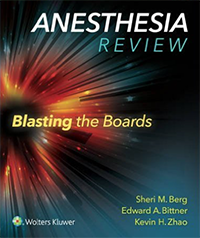
Edition 1 (2016)
Sheri Berg, Edward Bittner, Kevin Zhao
Prepare for success on in-training, certifying, and recertification exams! Anesthesia Review: Blasting the Boards is a high-yield study guide designed to maximize your study time and help you ace the written boards. A full-color, outline format features bulleted lists and numerous diagrams to facilitate quick memorization and information retrieval. It’s an ideal review resource for residents, CRNAs preparing for certification, and practitioners who need to recertify.
Key Features
22 succinct chapters cover the five content areas tested – basic sciences, clinical sciences, organ-based basic and clinical sciences, clinical subspecialties, and special problems or issues in anesthesiology.
Content is presented in high-yield, digestible chunks using a full-color, outline format.
Anesthesiology keywords are highlighted for quick memorization and retrieval.
Recently identified knowledge gaps are addressed in each chapter.
Every chapter concludes with five or more multiple choice questions and explanations.
Now with the print edition, enjoy the bundled interactive eBook edition, which can be downloaded to your tablet and smartphone or accessed online and includes features like:
Complete content with enhanced navigation
Powerful search tools and smart navigation cross-links that pull results from content in the book, your notes, and even the web
Cross-linked pages, references, and more for easy navigation
Highlighting tool for easier reference of key content throughout the text
Ability to take and share notes with friends and colleagues
Quick reference tabbing to save your favorite content for future use
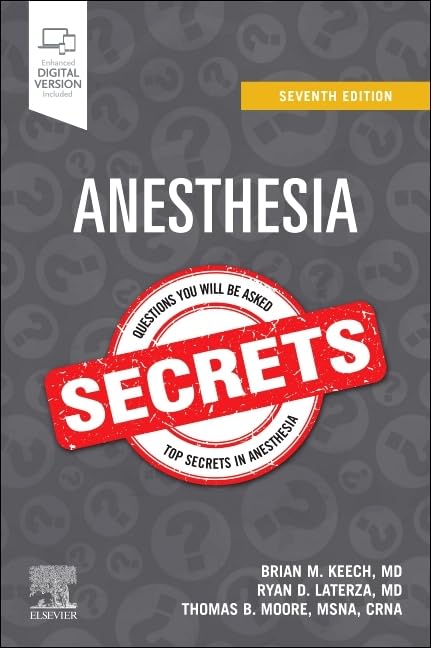
Edition 7 (2025)
Brian Keech, Ryan Laterza, Thomas Moore
For more than 30 years, the highly regarded Secrets Series® has provided students and practitioners in all areas of health care with concise, focused, and engaging resources for quick reference and exam review. Anesthesia Secrets, 7th Edition, offers practical, up-to-date coverage of the full range of essential topics in this dynamic field. This highly regarded resource features the Secrets’ popular question-and-answer format that also includes lists, tables, pearls, memory aids, and an easy-to-read style―making inquiry, reference, and review quick, easy, and enjoyable.
The proven Secrets Series® format gives you the most return for your time―succinct, easy to read, engaging, and highly effective
Fully revised and updated throughout, offering practical coverage of the full range of essential topics in the practice of anesthesiology, including protocols and guidelines that are continuously evolving and that increasingly dictate best practices
Contains new chapters on Infection Diseases and Anesthesia, Head and Neck Anesthesia, Anesthesia and the Developing World, and Non-Operating Room Anesthesia
Top 100 Secrets and Key Points boxes provide a fast overview of the secrets you must know for success in practice and on exams
Portable size makes it easy to carry with you for quick reference or review anywhere, anytime
Edition 3 (2022)
Jesse Ehrenfeld, Richard Urman, Scott Segal
This comprehensive update of the previous two successful editions covers both basic and advanced anesthesia topics. These include pharmacology, procedures, monitoring, equipment, subspecialty anesthesia, safety, professionalism, pain management, and more.
Chapters are concise, easy-to-read, and authored by faculty specialized in medical education. They feature case studies designed to help apply theoretical knowledge to real patient situations, as well as questions and answers.
A convenient resource for medical students, student registered nurse anesthetists, and student anesthesiologist assistants in any student of anesthesia will find this unique book useful.

Edition 6 (2019)
Richard Jaffe, Clifford Schmiesing, Brenda Golianu
Covering both surgical and anesthetic considerations, Anesthesiologist’s Manual of Surgical Procedures, Sixth Edition, is an essential resource for formulation of an anesthetic plan and perioperative management of patients. All chapters are written by both surgeons and anesthesiologists, giving you a detailed, real-world perspective on the many variables that accompany today’s surgical procedures.
Presents preoperative, intraoperative, and postoperative anesthetic considerations in a clear, templated format, summarizing all courses of action in easy-to-read tables.
Describes what the surgeon will likely be doing, variants of the procedure or approaches, patient population characteristics, and details of the procedure including positioning, length of procedure, postop care, and more.
Features a full-color design to enhance readability of the tables and clarity of the illustrations.
Updates to this edition include a new, heavily illustrated chapter overviewing regional blocks and new appendices covering individual components of enhanced recovery (ERAS) protocols and intraoperative use of transnasal humidified rapid-insufflation ventilatory exchange (THRIVE); as well as new, rapidly accessible tables and figures set on the inside back cover reviewing useful, but easily forgotten facts and dermatomes.
An ideal reference for anesthesiologists, anesthesia residents, and CRNAs.
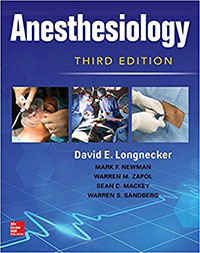
Edition 3 (2017)
David Longnecker, Mark Newman, Warren Zapol, Warren Sandberg, Sean Mackey
The gold-standard text in anesthesiology – from the field’s brightest, most respected minds
Written by an internationally known team of experts, Anesthesiology, Third Edition provides a 360-degree view of the field, covering all the anesthetic considerations from preoperative preparation through postoperative care, and the full breadth of anesthesia practice, including pain medicine and critical care medicine. Presented in full color and updated to capture the latest breakthroughs and advances, Anesthesiology is designed to provide the practitioner with an authoritative single-source reference that spans the full spectrum of anesthesia practice.
Much more than a how-to manual of anesthetic techniques, Anesthesiology, Third Edition presents an accessible compilation of concepts and principles that affirms its status as the cornerstone text in anesthesiology. This edition emphasizes important trends in both the specialty and healthcare in general. These trends include team-based anesthesia care, the remarkable growth of pain medicine practice, and the expanded need for clinicians who are skilled in the practice of critical care medicine.
Features:
• Four new pain medicine chapters, plus an expanded section on anesthetic considerations and perioperative management of co-existing disease
• Key Points and Key References encapsulate must-know information and guide you to important articles for further research
• Balanced presentations present clinical information, practical clinical procedures, and the molecular and scientific foundations of anesthesia practice
• Essential for residents and students preparing for initial certification, and for practitioners preparing for recertification
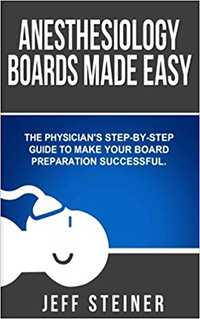
Edition 1 (2017)
Jeff Steiner
From the author of Anesthesia Made Easy comes the next step in your training to become an anesthesiologist.
When you became an anesthesiology resident, no one told you that you would have a full time job as an anesthesiology resident learning your craft and be a full time student getting ready for more exams. Since these exams will cost you both time and money, you will want to only have to take them once.
Trying to balance these two roles is difficult when there is so much to learn and only so much time. It is not enough that you have the knowledge, you have to know how to use it. You have worked too hard to get into anesthesiology residency training to blow it on not being able to become Board Certified. With such a high stakes game, where do you begin?
Anesthesiology Boards Made Easy is the insider’s strategy guide for residents to show you how to successfully play the game and become Board Certified. After all, if you were going to play a challenging game, you would try to figure out the objectives, rules, knowledge, strategy, tactics, and skills (plus a little luck) to win … right?
In this book, I will give you a roadmap to explain how the boards work, how to make your studying more efficient and less painful, and how to prepare for the most challenging exam of your career: The dreaded Applied Exam. (It is a 70 minute oral exam void of multiple choice questions given to you by experts in the field of anesthesiology. Some of the oral board examiners wrote the very books you will study to take the exam.)
Section One - The Game: You will learn the broad overview of how to become board certified.
Section Two - Doing Well on Your Written Exams: This is where we get into the strategies, tactics, and skills to pass your written exams. You will have several written exams to master including your USMLE/COMLEX Step 3, the Anesthesiology In Training Exam (ITE), the ABA Basic Exam, and the ABA Advanced Exam.
Section Three - Graduating From Residency: Most residents think they just have to show and get through. Not so. There are some residents who sail through residency and others who struggle. Learn how to efficiently maneuver through your training program.
Section Four - Passing Your Applied Exam: This is the largest section of the book, because you will be taking the Applied Exam as an oral exam. Starting in March 2018, you will also have an OSCE integrated to it as well. Learn how to prepare and take your first professional oral examination.
Section Five - Year by Year Checklists: With so much information in Anesthesiology Boards Made Easy where do you begin? This group of year by year checklists will meet you where you are in your training. It does not matter if you are an Intern or graduated from residency, this book will help you get ready for your exams.
What are you waiting for? Order your copy of Anesthesiology Boards Made Easy and build strategies, tactics, and skills into your Board studying which will help you become Board Certified with the least amount of pain possible.
Edition 1 (2017)
Linda Aglio, Richard Urman
Divided into twelve sections that cover the entirety of anesthetic practice, this is a case-based, comprehensive review of anesthesiology that covers the basics of anesthetic management and reflects all new guidelines and recently developed standards of care. Each chapter of Anesthesiology: Clinical Case Reviews begins with a specific clinical problem or a clinical case scenario, followed by concise discussions of preoperative assessment, intraoperative management, and postoperative pain management. In addition to residents and fellows, this book is written for practicing anesthesiologists, student nurse anesthetists, and certified registered nurse anesthetists (CRNAs).
Edition 2 (2024)
Brian Freeman, Jeffrey Berger
Anesthesiology Core Review: Part Two ADVANCED Exam is an all-in-one test-prep resource for mastering nearly 200 must-know topics, identifying your areas of strength and weakness, and waking up on test day with the utmost confidence.
Written by program directors with years of board examination advising experience, the book is designed in a way that facilitates quick, solid learning. It is divided into sections that match the American Board of Anesthesiology ADVANCED exam blueprint:
Basic Sciences
Clinical Sciences
Organ-based Basic & Clinical Sciences
Clinical Subspecialties
Special Issues in Anesthesiology
With its expert authorship and concise yet thorough coverage, Anesthesiology Core Review: Part Two ADVANCED Exam is one of the most important steps you can take to ensure effective preparation for the new ABA ADVANCED Examination.

Edition 2 (2023)
Brian Freeman, Jeffrey Berger
The essential, high-yield review for Part One of the ABA BASIC Exam―updated to align with the latest exam blueprint
Anesthesiology residents must pass the BASIC exam in order to continue their training. This essential resource is the single best way to take the stress out of this make-or-break exam, focus your study on nearly 200 must-know topics found on the board exam outline, and identify your areas of strength and weakness. Written by program directors with many years of board examination advising experience, Anesthesiology Core Review: Part One: BASIC Exam succinctly summarizes key concepts in basic science and clinical anesthesia practice. Space is conveniently provided throughout the book to add notes from other study resources. This updated second edition reflects the latest literature and incorporates new topics such as COVID-19.
Concise review of all essential anesthesia concepts
Great for keyword review and to generate power points for presentations
Content correlates with the two-part ABA content outline for board certification
Revised simultaneously with the Anesthesiology Core Review: Part Two: ADVANCED Exam
Aligns with the updated American Board of Anesthesiology (ABA) BASIC Exam blueprint and incorporates new content with American Society of Anesthesiology guidelines
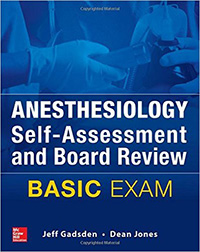
Edition 1 (2017)
Jeff Gadsen, Dean Jones
More than 800 high-yield Q&A provide the preparation you need to ace the ABA BASIC Examination
Here’s a great way to boost your confidence – and your score -- on the high-stakes American Board of Anesthesiology BASIC Exam. This powerful, results-oriented review delivers more than 800 questions and answers that cover a wide range of topics found on the ABA BASIC exam outline. Each question comes complete with a detailed answer explanation for both the correct and incorrect answer choices, along with references to essential texts to facilitate further study.
Anesthesiology Self-Assessment and Board Review: BASIC Exam is the perfect resource to supplement your daily reading in addition to the intense, streamlined study you want in the weeks and months before the exam.
Here’s why this is the best Q&A review for the ABA BASIC Exam:
• 800+ questions and answers cover the breadth of topics found on the exam
• Rich full-color presentation includes numerous clinically relevant drawings and photos
• Focuses on what you must know to pass the exam, enabling you to maximize your study time
• Content is based on the ABA BASIC Exam outline, so you know you are studying the most relevant, up-to-date material possible
• Detailed answer explanations for both correct and incorrect answers provide concept-clarifying “whys” behind each answer

Edition 1 (2019)
Diego Preciado, Susan Verghese
The advancement of tactics used in managing pediatric airway disorders can be attributed to an overall growth of collective knowledge among medical health professionals. This book is designed to sustain that growth of knowledge, with 18 chapters of insight and information by distinguished medical experts in both pediatric anesthesia and pediatric otolaryngology. It concisely and thoroughly covers topics such as subglottic stenosis, pharyngeal airway obstruction, laryngeal airway obstruction, obesity and sleep apnea and thoracic airway obstruction, among others. Chapters include scenarios where the skills and expertise of both anesthesiologists and otolaryngologists are being continually tested; the use of newer drugs and repurposing of older drugs; the combination of smaller amounts of different types of sedatives while avoiding intra-op narcotics and maintaining spontaneous ventilation are described in detail; Finally, a comprehensive review of new research emerging about ultra-rapid narcotics metabolizers among patients, making them more susceptible to medications, such as codeine, along with the latest information on the purported potential neurodevelopmental toxicity of some anesthetic agents are also included. Working as both an educational tool and a practical resource, medical practitioners, students and educators will find this text to be a valuable tool for the safely managing the pediatric patient undergoing anesthesia for difficult airway scenarios.

Edition 2 (2016)
Curtis Baysinger, Brenda Bucklin, David Gambling
Successfully combining the comprehensive depth of a textbook and the user-friendly features o fa practical handbook, A Practical Approach to Obstetric Anesthesia, 2nd Edition, is a portable resource for both experienced and novice clinicians. Focusing on clinical issues in obstetric anesthesia, it uses an easy-to-follow outline format for quick reference, enhanced with numerous tables, figures, and photographs. The use of color in this edition highlights key information and improves readability for daily practice and study.
Key Features:
Presents the most up-to-date information available in obstetric anesthesiology, including guidance on both routine and complicated patient care.
Features new chapters on ultrasound and echocardiographic techniques, trauma, management of the opioid dependent parturient, and maternal morbidity and mortality.
Covers pharmacology and physiology, antepartum considerations, labor and delivery, postpartum issues, and disease states in obstetric patients, including a chapter on obesity and pregnancy, as well as guidelines from national organizations.
Provides Clinical Pearls throughout, as well as Key Points in each chapter and current references for further study.
Now with the print edition, enjoy the bundled interactive eBook edition, which can be downloaded to your tablet and smartphone or accessed online and includes features like:
Complete content with enhanced navigation
Powerful search tools and smart navigation cross-links that pull results from content in the book, your notes, and even the web
Cross-linked pages, references, and more for easy navigation
Highlighting tool for easier reference of key content throughout the text
Ability to take and share notes with friends and colleagues
Quick reference tabbing to save your favorite content for future use

Edition 2 (2015)
Robert Holzman, Thomas Mancuso, David Polaner
Part of the highly popular Practical Approach to Anesthesia series, this new edition combines the comprehensive depth of a textbook and the user-friendly features of a practical handbook. Focusing on clinical issues in pediatric anesthesia, it contains the in-depth information you need for daily practice and study, presented in a concise, bulleted format for quick reference. With its emphasis on developmental aspects of pediatric anesthesia, numerous illustrations and tables, and methodical approach to decision making, this updated reference is an invaluable resource for anyone involved with anesthesia of children.
Key Features
Features new chapters on vascular biology and vascular anomalies, healing and recovery in pediatric surgery, and training and education in pediatric anesthesia. All existing chapters have been fully updated to keep you up to date.
Covers key issues of growth and development – anatomic, physiologic, and pharmacologic – that form the basis for a better understanding of pediatric anesthesia.
Discusses the approach to the pediatric patient, clinical and operational aspects of pediatric anesthesia, anesthetic management of normalities and abnormalities of each organ system, and special situations such as fetal surgery, anesthesia outside the operating room, and trauma.
Provides a clear understanding of anomalies, embryology, anatomy, and surgery so that you’re well prepared to choose the best induction, maintenance, and emergence techniques, as well as make informed monitoring and equipment decisions.
Presents information in a bulleted, outline format for easy reference and review.
Now with the print edition, enjoy the bundled interactive eBook edition, which can be downloaded to your tablet and smartphone or accessed online and includes features like:
Complete content with enhanced navigation
Powerful search tools and smart navigation cross-links that pull results from content in the book, your notes, and even the web
Cross-linked pages, references, and more for easy navigation
Highlighting tool for easier reference of key content throughout the text
Ability to take and share notes with friends and colleagues
Quick reference tabbing to save your favorite content for future use
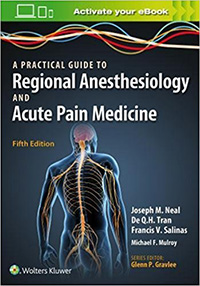
Edition 5 (2017)
Joseph Neal, De Tran, Francis Salina
Apply the latest advances in regional anesthesia and acute pain medicine!
Originally authored by Michael F. Mulroy, MD, this respected title has helped practitioners provide effective regional anesthesia for nearly 30 years. Now it has been retitled A Practical Approach to Regional Anesthesiology and Acute Pain Medicine to reflect the Accreditation Council for Graduate Medical Education’s recent establishment of Regional Anesthesiology and Acute Pain Medicine as an anesthesiology fellowship. This clinical reference has evolved with the many changes in this subspecialty to continue bringing you the up-to-date, clinically focused, hands-on guidance you need to offer your patients the best possible care.
Master the latest advances in the field with expanded coverage of truncal blocks, systems-based practice, acute pain medicine, and much more.
Make optimal use of ultrasound guidance as a nerve localization tool for peripheral nerve blocks, thanks to updated and expanded coverage as well as many new and improved illustrations.
The techniques, approaches, and systems-based practices covered in 5th edition will enhance the application and role of regional anesthesia in Enhanced Recovery After Surgery (ERAS) pathways and the perioperative surgical home. Easily find and apply the answers you need thanks to a highly readable, focused, richly illustrated format that provides balanced discussions of indications, complications, and techniques.
Your book purchase includes a complimentary download of the enhanced eBook for iOS, Android, PC & Mac. Take advantage of these practical features that will improve your eBook experience:
The ability to download the eBook on multiple devices at one time — providing a seamless reading experience online or offline
Powerful search tools and smart navigation cross-links that allow you to search within this book, or across your entire library of VitalSource eBooks
Multiple viewing options that enable you to scale images and text to any size without losing page clarity as well as responsive design
The ability to highlight text and add notes with one click
See the inside front cover to find out how to access your eBook!
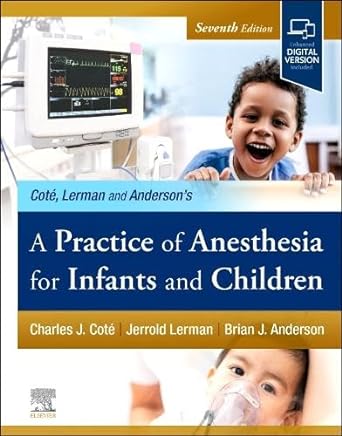
Edition 7 (2024)
Charles Cote, Jerrold Lerman, Brian Anderson
Covering everything from preoperative evaluation to neonatal emergencies to the PACU, Coté, Lerman and Anderson’s A Practice of Anesthesia in Infants and Children, 7th Edition, features state-of-the-art advice on the safe, effective administration of general and regional anesthesia and sedation strategies for young patients. This text reviews underlying scientific information, addresses preoperative assessment and anesthesia management in detail, and provides guidelines for postoperative care, emergencies, and special procedures. Comprehensive in scope and thoroughly up to date, this edition delivers unsurpassed coverage of every key aspect of pediatric anesthesia.
Presents must-know information on standards, techniques, and the latest advances in pediatric anesthesia from global experts in the field.
Contains thoroughly updated content throughout, with new contributors to lend a fresh perspective, updated figures and tables, and the latest information on perioperative fluid management, pharmacology, interventional devices, resuscitation, and more.
Covers key topics such as anesthetizing children with cancer, neonatal and pediatric emergencies, the obese child and bariatric surgery, interventional devices for children with congenital heart defects, cardiopulmonary resuscitation, simulation in pediatric anesthesia, patient safety and quality assurance, and more.
Features an extensive video library of pediatric anesthesia procedures, particularly difficult airway management strategies, new positioning devices, cardiac assist devices in action, management of burn injuries, how to perform ultrasound-guided regional anesthesia blocks and techniques, and much more.
Essentials chapters provide focused input from expert subspecialty pediatricians who share the latest information concerning hematology, pulmonology, oncology, hepatology, nephrology, and neurology.
Includes a laminated pocket reference guide with essential, practical information, and key references at the end of each chapter that provide a quick summary for review. An extended online version is available in the app (“Pedi Anesth”; Starship Children’s Hospital, Auckland District Health Board, NZ).
An eBook version is included with purchase. The eBook allows you to access all of the text, figures, and references, with the ability to search, customize your content, make notes and highlights, and have content read aloud. Any additional digital ancillary content may publish up to 6 weeks following the publication date.
Edition 1 (2016)
George Williams, Erin Williams
Basic Anesthesiology Examination Review is a high-yield, streamlined study aid specifically designed for Anesthesiology residents preparing for the American Board of Anesthesiology (ABA) Basic Anesthesiology Exam. Chapters deliver succinct and efficiently communicated summaries of all content listed in the ABA exam outline, plus highlighted key facts, mneomnics, and relevant images and diagrams. Chapters conclude with board-style practice questions and annotated answers, followed by key references and further reading. With this book as a guide, readers will be able to efficiently prepare for the Basic Anesthesiology Examination and master the key facts and concepts that provide the scientific roundation for the practice of Anesthesiology.
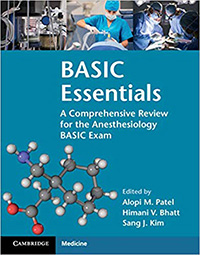
Edition 1 (2019)
Alopi Patel, Himani Bhatt, Sang Kim
Focused and results-based, this important board review title covers everything that residents need to know when preparing for their Anesthesiology BASIC exam. Written by residents familiar with the exam, its use of bullet points and illustrations enables effective learning and efficient exam preparation. Providing a comprehensive review of all exam topics, the guide uses a clear and focused note-taking style to present 'high-yield' information, enabling efficient study techniques. Bullet points and short paragraphs feature to help rapid understanding, with margin space provided to annotate and add further notes. The helpful format ensures that all exam preparation, including notes from question banks, can be kept in this 'one-stop' review book. Mirroring the BASIC exam requirements, this book covers clinical anesthetic practice, pharmacology, physiology, anatomy, and anesthesia equipment and monitoring. Written by residents for residents, it is an essential preparation resource for the Anesthesiology BASIC exam.
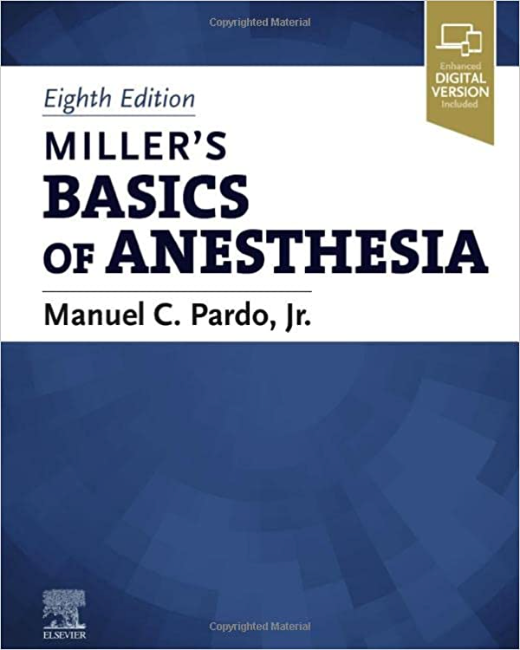
Edition 8 (2022)
Manuel Pardo
Long regarded as the undisputed leading text of its kind, Miller’s Basics of Anesthesia provides comprehensive yet concise coverage of both basic science and clinical topics in anesthesiology. Under the experienced editorial leadership of Dr. Manuel C. Pardo, Jr., the 8th Edition has been meticulously updated to reflect the latest advances in practice and important aspects of contemporary anesthesia care, including pathophysiology, pharmacology, regional anesthesia, anesthetic management, and special problems and patient groups. It remains the first learning resource of choice for anesthesia providers, including anesthesia residents and fellows, medical students, and student registered nurse anesthetists, and is also a valuable review tool for practitioners undergoing maintenance of certification or recertification.
Features a reader-friendly format with color-coded section tabs, easy-to-read chapters, and a concise writing style, along with color patterns in every chapter for quick navigation.
Contains new chapters on Clinician Well-Being, Perioperative Point-of-Care Ultrasound, Environmental Impact of Anesthetics, and Perioperative Medicine.
Covers key topics such as anesthesia neurotoxicity, palliative care, sleep medicine, trauma, and much more.
Includes high-quality images that offer a detailed visual understanding of complex topics, while numerous figures and tables condense material for easier retention and review.
Shares the knowledge and experience of renowned anesthesia expert Dr. Manuel C. Pardo, Jr. and a team of more than 80 global contributing authors.
Serves both as an initial learning resource and a useful tool for solidifying the essential “must know information and reviewing core knowledge for maintenance of certification.
Enhanced eBook version included with purchase. Your enhanced eBook allows you to access all of the text, figures, and references from the book on a variety of devices.
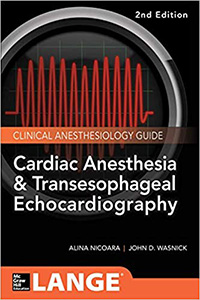
Edition 2 (2019)
John Wasnick, Alina Nicoara, Zak Hillel
"An essential resource for anesthesiologists new to the cardiac operating room
Cardiac Anesthesia and Transesophageal Echocardiography, Second Edition is a fast and effective way for anesthesia trainees to acquire the skills necessary to successfully navigate the cardiac operating room. Clinically focused, this unique guide imparts the basic principles of both cardiac anesthesia and echocardiography in a way that reflects the realities of real-world practice.
Whether you are looking for a concise, easy-to-read introduction to cardiac anesthesiology or a primer on incorporating the basic principles of cardiac anesthesiology and perioperative echocardiography into real-world practice, Cardiac Anesthesia and Transesophageal Echocardiography is the trusted one-stop guide to mastery of these two critical topics.
This edition includes online access to nearly 100 narrated, labeled TEE clips that illustrate normal and abnormal echocardiographic views. Each clip is keyed to a specific passage in the text, which provides the reader with a true multimedia learning experience."
Edition 1 (2019)
Mohammed Minhaj, Magdalena Anitescu
Cardiac Anesthesia: A Problem-Based Learning Approach provides a comprehensive review of the dynamic and ever-changing field of cardiac anesthesia. Its problem-based format incorporates a pool of multiple-choice questions for self-assessment. Each of its 36 case-based chapters is accompanied by questions and answers, accessible online in a full practice exam. The cases presented are also unique, as each chapter starts with a case description, usually a compilation of several actual cases; it then branches out through case-based questions, to increasingly complex situations. This structure is designed to create an authentic experience that mirrors that of working through the nuances of a complicated clinical scenario. The discussion sections that follow offer a comprehensive approach to the chapter's subject matter, thus creating a modern, complete, and up-to-date medical review of that topic.
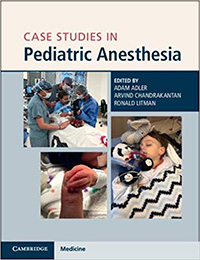
Edition 1 (2019)
Adam Adler, Arvind Chandrakantan, Ronald Litman
Pediatric anesthesiologists will encounter numerous challenges when caring for children as their work involves more than simply adjusting drug dosages and equipment for smaller patients. In response, this practical book provides clinical guidance in an easily-accessible and digestible question-answer format. Case Studies in Pediatric Anesthesia reviews the entire breadth of pediatric anesthesia and pain management, taking a case-based approach. Each chapter commences with a clinical case or scenario, guiding the reader through a tailored discussion. The chapters review the pathophysiology, anesthetic techniques and surgical and perioperative considerations. High quality tables and figures feature throughout to help solidify key concepts. The chapters are prepared to be read in isolation and for reference when appropriate. Case Studies in Pediatric Anesthesia is aimed at anesthesiologists of all levels, from the trainee on their first pediatric rotation, to the pediatric fellow preparing for boards examination to the seasoned clinician.

Edition 5 (2019)
David Chestnut, Cynthia Wong, Lawrence Tsen, Warwick Ngan Kee, Yaakov Beilin, Jill Mhyre, Brian Bateman, Naveen Nathan
Comprehensive, user-friendly, and up to date, Chestnut's Obstetric Anesthesia: Principles and Practice, 6th Edition, provides the authoritative clinical information you need to provide optimal care to your patients. This substantially revised edition keeps you current on everything from basic science to anesthesia techniques to complications, including coverage of new research that is paving the way for improved patient outcomes. An expert editorial team ensures that this edition remains a must-have resource for obstetric anesthesiologists and obstetricians, nurse anesthetists and anesthesiology assistants, and anesthesiology and obstetric residents and students.
Presents the latest information on anesthesia techniques for labor and delivery and medical disorders that occur during pregnancy, emphasizing the treatment of the fetus and the mother as separate patients with distinct needs.
Contains new chapters on shared decision-making in obstetric anesthesia and chronic pain during and after pregnancy.
Features extensive revisions from cover to cover, including consolidated information on maternal infection and postoperative analgesia.
Covers key topics such as neonatal assessment and resuscitation, pharmacology during pregnancy and lactation, use of nitrous oxide for labor analgesia, programmed intermittent epidural bolus (PIEB) technique, epidural analgesia-associated fever, the role of gastric ultrasonography to assess the risk of aspiration, sugammadex in obstetric anesthesia, the role of video laryngoscopy and new supraglottic airway devices, spinal dysraphism, and cardiac arrest in obstetric patients.
Incorporates the latest guidelines on congenital heart disease and the management of sepsis, as well as difficult airway guidelines that are specific to obstetric anesthesia practice.
Offers abundant figures, tables, and boxes that illustrate the step-by-step management of a full range of clinical scenarios.
Enhanced eBook version included with purchase. Your enhanced eBook allows you to access all of the text, figures, and references from the book on a variety of devices.
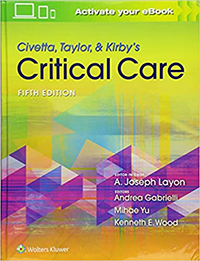
Edition 5 (2017)
A. Joseph Layon, Andrea Gabrielli, Mihae Yu, Kenneth Wood
Covering every problem encountered in today’s intensive care unit, this leading critical care textbook presents the knowledge and expertise of more than 350 global experts in this fast-changing field. Beginning with the social aspects of medicine, it then discusses monitoring and organ system pathobiology followed by specific diseases states/syndromes. Each chapter begins with immediate concerns and proceeds to broader-based discussions of relevant pathophysiologic and clinical issues.
KEY FEATURES:
Features new chapters on Critical Care Implications in Acute Care Surgery, The Obstetric Patient, and Brain Death and Management of the Potential Organ Donor; all chapters thoroughly revised including up-to-date discussions of what happens after the patient leaves the ICU.
Covers surgical critical care more thoroughly than any other text.
Includes expert coverage of pharmacology, nutrition, toxicology and the environment, disaster management, point-of-care testing, bedside ultrasound, surgical infections, and much more.
Presents information in a reader-friendly manner, streamlining the print text to focus on the material most important for bedside care in the ICU.
Expertly edited by leaders in every area of critical care: Dr. Mihae Yu (surgery), Dr. A. Joseph Layon (internal medicine), and Drs. Layon and Andrea Gabrielli (anesthesiology), who are joined in this edition by Dr. Kenneth Wood (internal medicine).
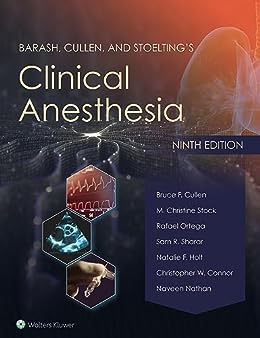
Edition 9 (2023)
Bruce Cullen, M. Christine Stock, Rafael Ortega, Sam Sharar, Natalie Holt, Christopher Connor, Naveen Nathan
Covering the full spectrum of clinical issues and options in anesthesiology, Barash, Cullen, and Stoelting’s Clinical Anesthesia, Ninth Edition, edited by Drs. Bruce F. Cullen, M. Christine Stock, Rafael Ortega, Sam R. Sharar, Natalie F. Holt, Christopher W. Connor, and Naveen Nathan, provides insightful coverage of pharmacology, physiology, co-existing diseases, and surgical procedures. This award-winning text delivers state-of-the-art content unparalleled in clarity and depth of coverage, as well robust multimedia features that equip you to effectively apply today’s standards of care and make optimal clinical decisions on behalf of your patients.
Comprehensively covers the entire field of anesthesiology with a practical, clinical focus throughout
Features extensive multimedia content, including more than 300 updated procedural videos and 190 narrated interactive clinical vignettes
Includes Key Points in every chapter, with corresponding numbers in the chapter margins for quick reference
Highlights key references to quickly direct you to the most important and high-yield further reading
Contains useful appendices with formulas, pacemaker and implantable cardiac defibrillator protocols, information on herbal medications, an atlas of echocardiography, and more.
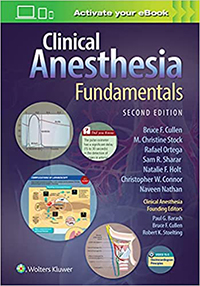
Edition 2 (2021)
Bruce Cullen, M. Christine Stock, Rafael Ortega, Sam Sharar, Natalie Holt, Christopher Connor, Naveen Nathan
Part of the popular and well-regarded Clinical Anesthesia family of titles, and founded by Drs. Paul G. Barash, Bruce F. Cullen, and Robert K. Stoelting, Clinical Anesthesia Fundamentals, Second Edition, is a concise, highly visual resource covering the core concepts in anesthesiology. The editorial board comprised of Drs. Bruce F. Cullen, M. Christine Stock, Rafael Ortega, Sam R. Sharar, Natalie F. Holt, Christopher W. Connor, and Naveen Nathan, and their team of expert contributors clearly and simply present the information you need on key aspects of anesthesia for every specialty area and key organ systems. From physiology and pharmacology to anatomy and system-based anesthesia, it uses full-color graphics, easy-to-read tables, and clear, concise text to convey the essential principles of the field.
Presents material in a highly visual manner, including “Did You Know” boxes that highlight key points, as well as video boxes that reference more than 120 short, to-the-point tutorial videos in the eBook, in addition to end of chapter multiple choice questions, answers, and explanations.
New features include: a chapter on anesthesia for the older patient as well as 31 chapter-based infographics that provide “At a Glance” or “A Closer Look” at topical content.
The ebook also comes with access to question-based interactive versions of the infographics, as well as dozens of video lectures covering every chapter in the book, including 500integrated review questions throughout.
Includes an introductory section covering scientific and technical foundations, pharmacology, and technology.
Features helpful appendices with handy formulas; an electrocardiography atlas; numerous key protocols, guidelines, and standards; algorithms, and more.
Ideal for medical students, residents, SRNAs, CRNAs, and practitioners studying for board exams—anyone who needs a quick overview of the essential elements of clinical anesthesia in an easily accessible format.
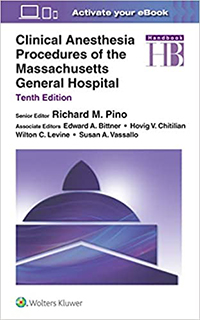
Edition 10 (2021)
Richard Pino, Edward Bittner, Hovig Chitilian, Wilton Levine, Susan Vassallo
Written by residents and attendings at the world-renowned Massachusetts General Hospital Department of Anesthesia, Clinical Anesthesia Procedures of the Massachusetts General Hospital, Tenth Edition, offers current, comprehensive, and concise guidelines on all facets of anesthesia, perioperative care, critical care, and pain management. Emphasizing the clinical fundamentals necessary for patient safety and optimal outcomes, this trusted guide provides fast answers to the most frequent problems encountered in daily anesthetic practice, making it an invaluable resource for practicing anesthesiologists and residents as well as nurse anesthetist trainees and practitioners.
Focuses on the clinical fundamentals needed for the safe delivery of anesthesia and perioperative care in day-to-day practice.
Uses an easy-to-scan outline format that progresses intuitively from preoperative evaluation through administration of anesthesia to perioperative issues for each subject.
Updated and reorganized table of contents in addition to chapters on evaluating the patient, anesthesia for pediatric surgery and care of the neonate, non-operating room anesthesia and pain management.
Includes new chapters on the basics of echocardiography, anesthesia for orthopedic surgery, anesthesia for transplant surgery and vascular access. Features appendices covering drugs and intravenous antibiotics.
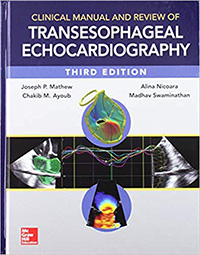
Edition 3 (2019)
Joseph Mathew, Madhav Swaminathan, Chakib Ayoub, Alina Nicoara
Clinical Manual and Review of Transesophageal Echocardiography, Third Edition is written to be the field’s go-to resource and the standard reference textbook on the topic. It offers concise yet comprehensive coverage of the key principles, concepts, and developing practice of transesophageal echocardiography.
Completely updated, reorganized, and expanded, this Third Edition features a sectional format, each containing chapters that were reviewed and revised to provide a comprehensive discussion of physiology, pathophysiology, and echocardiographic approach for normal and common disease states. Where possible, important clinical information has been aligned with the principles of cardiovascular physiology and echocardiographic techniques. Narrative text, charts, videos, and graphs have been effectively integrated to provide rapid access to key clinical information for the purpose of improving clinical management.
Features:
•Addresses all the important clinical and technical issues and major exam topics
•Valuable appendices detailing normal chamber dimensions and volumes; wall motion and coronary perfusion; diastolic function; native valve areas, velocities, and gradients; and measurements and calculations
•Contributions from leading anesthesiologists, cardiologists, and cardiothoracic surgeons
•A complete practice exam and chapter-ending multiple choice questions make this the perfect review for board examinations in both basic and advanced perioperative echocardiography
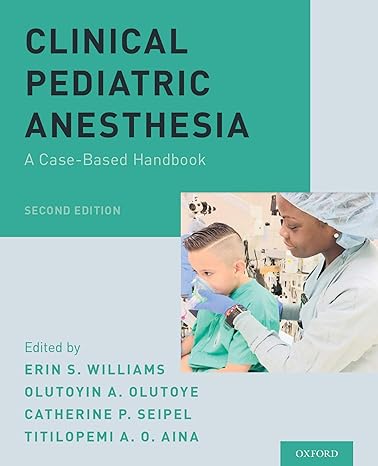
Edition 2 (2018)
Erin Williams, Olutoyin Olutoye, Catherine Seipel, Titilopemi Aina
This second edition of Clinical Pediatric Anesthesia: A Case-Based Handbook offers a comprehensive review of the options, advantanges, and disadvantages of different aspects of the perioperative management of the pediatric patient, as well as examples of a wide range of relevant clinical scenarios. Chapters are organized into 15 sections and cover the field of pediatric anesthesiology with a point-of-care approach. Written by a team of over 50 Pediatric Anesthesiologists at tertiary children's hospitals, this highly accessible text provides readers with multiple approaches to the anesthetic care of the pediatric patient. Each chapter includes an introduction to the topic, followed by learning objectives, clinical vignettes, and a discussion section styled in a question-and-answer format, concluding with a summary of the highest-yield and most salient information. Chapters also provide annotated references and suggestions for further reading to facilitate in-depth study of topic. The variety of cases presented, along with the contributors' expertise, render valuable real-life clinical situations that promote critical thinking and evaluation necessary for all pediatric anesthesiology consultants.
Edition 1 (2019)
Kai Matthes, Herodotus Ellinas
A new textbook of pediatric anesthesiology – modeled after the bestselling Morgan and Mikhail’s Clinical Anesthesiology
Filling a void in the anesthesiology literature, this new text delivers streamlined yet comprehensive discussion of the unique aspects and considerations necessary to successfully manage pediatric patients.
For each procedure covered, there is a review of equipment, technique, alternatives, and ways to manage complications or troubleshoot errors. A complete multi-media resource, LANGE Clinical Pediatric Anesthesiology includes a link to 50 videos depicting key pediatric anesthetic procedures. This unique resource is ideal for trainees and practitioners who have limited time and need a solution to a specific clinical problem. Sections include: Basic Science, Pharmacology, Anesthetic Practice, Procedures, and Special Considerations.

Edition 1 (2021)
Michael Levitzky
A clinically relevant, reader -friendly text covering everything the anesthesia provider must know about physiology
This well-illustrated new resource is the most concise and high-yield presentation of physiology topics available to the anesthesia provider. The authors (who are both educators and clinicians) deliver a complete overview of physiology, but, since this book is written for the anesthesia provider, the bulk of the text is dedicated to cardiovascular and respiratory physiology. Clinical Physiology in Anesthetic Practice distinguishes itself from general medical physiology books by the inclusion of case studies and clinical correlation boxed inserts that emphasize key fact that relate to real-world practice.
•Numerous case studies demonstrate the clinical relevance of basic science
•The author are experienced educators and clinicians, and know how to present difficult concepts in the most interesting and reader-friendly manner possible
•Key Points summarize must-know information, providing an excellent framework for board review

Edition 1 (2021)
Edmond Cohen
Ideal for clinicians at all levels of experience―from the resident to the subspecialist―Cohen’s Comprehensive Thoracic Anesthesia compiles the many recent advances in thoracic anesthesiology into one convenient, easy-to-use reference. Concise, clinically focused chapters written by international authorities in the field cover all facets of anesthesia practice for thoracic procedures, logically organized by preoperative, intraoperative, and postoperative considerations.
Discusses new devices for lung isolation, new lung protection protocols, new information on post-operative complications, and new drugs for modulating pulmonary circulation.
Covers 20 key procedures including tracheal resection, esophagectomy, mediastinoscopy, mediastinal mass, SVC syndrome, and more.
Describes complex surgeries related to the lungs, pleura, diaphragm, and esophagus.
Provides case studies and clinical vignettes to illustrate and support case management decisions.
Offers highly practical guidance for quick reference from editor Dr. Edmond Cohen and a team of expert contributing authors from around the world.
Features extensive illustrations throughout, including clinical photos and drawings, radiographic images, device images, charts, and graphs.
Enhanced eBook version included with purchase. Your enhanced eBook allows you to access all of the text, figures, and references from the book on a variety of devices.

Edition 3 (2017)
Lee Fleisher, Stanley Rosenbaum
Using a unique, problem-solving approach, Complications in Anesthesia, 3rd Edition, walks you through effective solutions to common complications in anesthesia and critical care. This practical reference uses a highly structured, clearly illustrated format to bring you up to date with what’s new in the field, help you anticipate potential challenges, and guide you through life-saving solutions.
Presents content in an updated, logical organization covering various types of complications (drugs, testing, intubation, line insertion, surgical procedures, etc.) followed by differential diagnosis and treatment of signs of complications (intraoperative, such as hypoxia or hypotension; and postoperative, such as MI).
Follows a problem-based, practice-oriented approach throughout; case synopses are followed by concise coverage of recognition, risk assessment, implications, management, and prevention.
Allows you to review the case reports, contemplate the implications, then check your response against what the experts have to say.
Includes numerous photographs, diagrams, flow charts, and tables that illustrate key concepts.
Ideal as a clinical reference and as a study tool when preparing for oral boards.
Brings you up to date with new safety standards and the latest ASA guidelines.
Expert Consult™ eBook version included with purchase. This enhanced eBook experience allows you to search all of the text, figures, and references from the book on a variety of devices.
Edition 1 (2018)
A. Agatha Crear-Gilbert, Mark MacGregor
Part of the popular Core Topics series, this book provides a practical guide to pre-operative assessment for consultants and trainee anaesthetists. Chapters cover comprehensive evidence-based guidance for assessing and managing patients with particular conditions, as well as perioperative risk stratification and challenges of pre-assessment. The chapters have been written by specialists in the respective clinical fields, while all content has been edited by anaesthetists to assure it is relevant and accessible to the anaesthetist in the everyday pre-operative clinic. Written specifically for anaesthetists, this resource will allow every reader to contribute effectively in a multidisciplinary approach when assessing and risk stratifying patients to ensure that they are optimised before surgery.
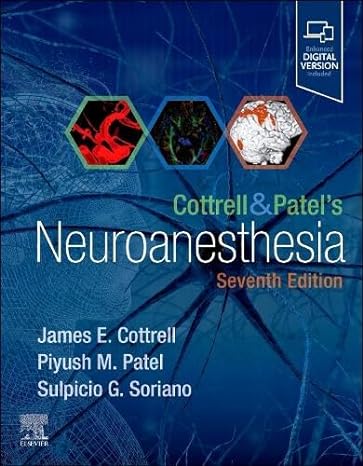
Edition 7 (2024)
James Cottrell, Piyush Patel
Balancing must-know scientific knowledge with clinical applications, Cottrell and Patel's Neuroanesthesia, 7th Edition, reflects the latest developments in neurosurgical anesthesia, providing a comprehensive, authoritative overview of this challenging field. Clinically oriented chapters offer key clinical points, case presentations, and discussions, delivering the complete and authoritative guidance you need to ensure optimal perioperative care and safety for neurosurgical patients. Broad, clearly organized coverage of all important aspects of neuroanesthesia enables you to find reliable answers to any clinical question.
Integrates current scientific principles with the newest clinical applications, including current clinical management guidelines for neurosurgical patients.
Provides expert guidance on what to do under a variety of circumstances, the logic behind why it should be done, and tips for avoiding complications.
Includes clear, conceptual illustrations throughout, along with neuroimaging, clinical photos, charts and graphs, and clinical algorithms, making complex concepts easier to understand at a glance.
Covers the latest advancements in the field including cerebrospinal fluid hemodynamics and physiology, minimally invasive techniques, brain tissue oxygenation oximetry, microdialysis, neuroimaging and neurointerventional radiology, traumatic brain injury, pediatric neuroanesthesia, and acute treatment of depression.
An eBook version is included with purchase. The eBook allows you to access all of the text, figures, and references, with the ability to search, customize your content, make notes and highlights, and have content read aloud. Any additional digital ancillary content may publish up to 6 weeks following the publication date.

Edition 7 (2023)
Edward Bittner
With concise, full-color coverage of this rapidly enlarging field, Critical Care Handbook of the Massachusetts General Hospital, Seventh Edition, is your go-to guide for practical, complete, and current information on medical and surgical critical care. Edited by Drs. Edward A. Bittner, Lorenzo Berra, Peter J. Fagenholz, Jean Kwo, Jarone Lee, and Abraham Sonny, this user-friendly handbook is designed for rapid reference, providing reliable, hospital-tested protocols that reflect today's most advanced critical care practices. An at-a-glance outline format and portable size make it an essential manual for medical students, residents with rotations in ICUs, and physicians and nurses who work in critical care.
Reflects a multidisciplinary approach throughout, in a convenient size for on-the-go reference
Contains well-written, comprehensive coverage of general principles, specific considerations such as ARDS, and health care services such as ICU handoffs and transitions
Uses an efficient outline format with bolded key words and concepts
Includes new chapters on critical care management of COVID-19, heart failure, and pulmonary hypertension
Written by MGH attendings, fellows in critical care, nurses, and residents in anesthesia, critical care, and pain medicine, with input from surgery, pulmonary care, pediatrics, neurology, and pharmacy
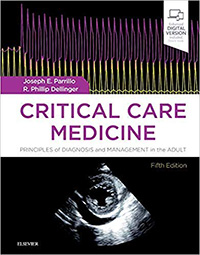
Edition 5 (2019)
Joseph Parrillo, Philip Dellinger
Now completely revised to bring you up to date with the latest advances in the field, Critical Care Medicine: Principles of Diagnosis and Management in the Adult, 5th Edition, delivers expert, practical guidance on virtually any clinical scenario you may encounter in the ICU. Designed for intensivists, critical care and pulmonology residents, fellows, practicing physicians, and nurse practitioners, this highly regarded text is clinically focused and easy to reference. Led by Drs. Joseph Parrillo and Phillip Dellinger, the 5th Edition introduces numerous new authors who lend a fresh perspective and contribute their expertise to that of hundreds of top authorities in the field.
Includes new chapters on current applications of bedside ultrasound in the ICU, both diagnostic and procedural; mechanical assist devices; and extra-corporeal membrane oxygenation (ECMO).
Contains new administrative chapters that provide important information on performance improvement and quality, length of stay, operations, working with the Joint Commission, and more.
Features new videos and images that provide visual guidance and clarify complex topics.
Keeps you up to date with expanded chapters on echocardiography in the ICU and valvular heart disease, including TAVR.
Includes separate chapters on mechanical ventilation of obstructive airway disease and acute respiratory distress syndrome (ARDS) – including the many recent changes in approach to positive end expiratory pressure setting in ARDS.
Covers key topics such as patient-ventilator synchrony and non-invasive ventilation for treating chronic obstructive pulmonary disease patients with acute respiratory failure.
Reflects the recent literature and guidance on amount of fluids, type of fluid, vasopressor selection, mean arterial pressure target, and decision on steroid use in septic shock.
Provides questions and answers in every chapter, perfect for self-assessment and review.
Enhanced eBook version included with purchase. Your enhanced eBook allows you to access all of the text, figures, and references from the book on a variety of devices.
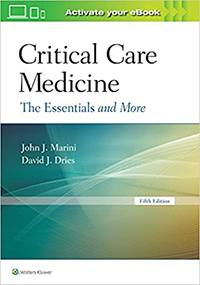
Edition 5 (2018)
John Marini, David Dries
With a full-color design and concise, easy-to-read chapters, Critical Care Medicine: The Essentials and a Bit More covers the core elements of critical care, with a unique focus on the pathophysiology underlying clinical disorders and how pathophysiologic concerns affect treatment options. There is much here that’s new: brand-new content, expanded discussions, and more graphical elements than ever before. Chapters follow a consistent structural template, with discussions of diagnosis, instrumentation, treatment and management techniques, and more. Expertly and succinctly captures all the fundamentals of the field!
Designed primarily for use by students and residents, but also helpful for anyone already in practice.
Emphasizes the pathophysiologic elements and treatments of illness and injury.
Now with updated drug info and more substantial coverage of interventional radiology, pregnancy care, and organization of critical care.
Adds new, brief summaries that present opposing arguments of controversial points.
Topics range from intubation, ventilation, and pharmacotherapy, as well as drug overdoses, sepsis, gastrointestinal bleeding, and other crisis care scenarios.

Edition 6 (2018)
Polly Parsons, Jeanine Wiener-Kronish, Lorenzo Berra, Renee Stapleton
For more than 30 years, the highly regarded Secrets Series® has provided students and practitioners in all areas of health care with concise, focused, and engaging resources for quick reference and exam review. Critical Care Secrets, 6th Edition, features the Secrets’ popular question-and-answer format that also includes lists, tables, and an easy-to-read style – making reference and review quick, easy, and enjoyable.
Fully updated throughout, with new chapters on neurological monitoring, obesity in the ICU, new ultrasound practices, ICU survivorship, and the latest cardiac technology such as ventricular assist and percutaneous support devices.
Written and fully updated by clinical and thought leaders in critical care who have contributed chapters in their areas of expertise.
The proven Secrets Series® format gives you the most return for your time – concise, easy to read, engaging, and highly effective.
Covers the full range of essential topics in critical care for in-training or practicing professionals, including anatomy, physiology, immunology, and inflammation – fundamentally important topics in the effective care of critically ill patients.
Top 100 Secrets and Key Points boxes provide a fast overview of the secrets you must know for success in practice and on exams.
Portable size makes it easy to carry with you for quick reference or review anywhere, anytime.
Expert Consult™ eBook version included with purchase. This enhanced eBook experience allows you to search all of the text, figures, and references from the book on a variety of devices.
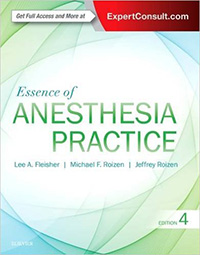
Edition 4 (2017)
Lee Fleisher, Michael Roizen, Jeffrey Roizen
Essence of Anesthesiology Practice makes it easy to formulate anesthesia plans through a consistent format and discussions of the problems, causes, comorbidities, and anesthesia implications for over 600 clinical topics. Drs. Fleisher and Roizen present a completely revised new edition that includes coverage of many new conditions, procedures, and drugs. Online access to the fully searchable text at www.expertconsult.com means that you can get the information you need more easily and conveniently.
Easily formulate anesthesia plans through a consistent format that covers a single clinical topic on each page, with a review of its problems, causes, comorbidities, and anesthesia implications.
Get state-of-art, reliable coverage from an international team of experts who discuss common and rare conditions and how to manage them.
Understand the interactions of common drugs and alternative medicine so that you can develop anesthesia plans accordingly.
Access the fully searchable text online at www.expertconsult.com.
Quickly reference key information using the carefully templated text that highlights the most important anesthetic considerations in a consistent, user-friendly layout.
Stay current on the latest anesthetic implications in regards to coexisting diseases, procedures, drugs, and alternative and complementary therapies, including coverage of mitochondrial myopathy, atrial fibrillation ablation, awake craniotomy, stereotactic neurosurgery, neuroprotection, dexmedetomidine, and other hot topics.
Master the core knowledge of Anesthesia and overcome new factors in anesthetic care of patients with trusted reference in a high yield format
Edition 1 (2015)
Linda Aglio, Robert Lekowski, Richard Urman
This concise, evidence-based board review book, organized according to the ABA keyword list, covers all the fundamental concepts needed to pass written and re-certification board examinations. Each chapter begins with a case scenario or clinical problems from everyday practice, followed by concise discussion and clinical review questions and answers. Discussion progresses logically from preoperative assessment and intraoperative management to postoperative pain management, enhancing the reader's knowledge and honing diagnostic and clinical management skills. New guidelines and recently developed standards of care are also covered.

Edition 1 (2018)
Mary Ellen McCann, Christine Greco, Kai Matthes
It is estimated that 1.5 million infants undergo surgery and anesthesia in the USA each year. However, there are serious concerns within the pediatric anesthesia community regarding the safety of anaesthesia in infants and children. There is mounting evidence from animal studies that anesthetics in common clinical use are neurotoxic to the developing brain and cause long-term neurobehavioral abnormalities. Essentials of Anesthesia for Infants and Neonates provides a comprehensive guide to the special needs of infants undergoing anesthesia. It focuses on the first year of life, the time when anesthesia mortality and morbidity is highest. Chapters are illustrated in color throughout, and include sections on newborn physiology for anesthetic management, specific procedures, pain management, and topics such as regional anesthesia and sedation. Written by nationally recognized experts, this book will become an invaluable point of reference for any physician interested in pain management in the first year of life.

Edition 3 (2015)
Paul Ellis Marik
This is the premier evidence-based textbook in critical care medicine. The Third Edition features updated and revised chapters, numerous new references, streamlined content, and new chapters on key topics such as the new paradigm in critical care medicine, cardiac output monitoring, surgical optimization, vital signs, and arterial blood gas analysis. The book maintains the author’s trademark humor and engaging writing style and is suitable for a broad and diverse audience of medical students, residents, fellows, physicians, nurses, and respiratory therapists who seek the latest and best evidence in critical care.
From reviews of previous editions:
“This is an excellent introduction to the concept of evidence-based medicine...The writing is clear, logical, and highly organized, which makes for fast and enjoyable reading. I believe this book will get daily use in most intensive care units, by a wide range of readers.” –Respiratory Care
“This is one of the most comprehensive handbooks on critical care medicine with a strong emphasis on evidence base…Overall, this book should be useful for junior doctors or intensive care trainees who are starting their term in an intensive care unit.” –Anaesthesia and Intensive Care
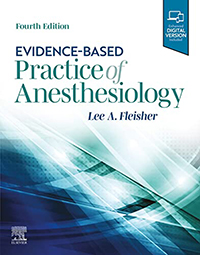
Edition 4 (2022)
Lee Fleisher
Addressing both routine and complex situations with practical decision-making tools, Evidence-Based Practice of Anesthesiology, 4th Edition, helps anesthesiologists make sound decisions in everyday practice. World-renowned authority, Dr. Lee A. Fleisher, takes an evidence-based approach to a variety of high-impact topics related to effective perioperative patient management: preoperative assessment; monitoring and administration of anesthesia during surgery; postoperative intensive care management; and postoperative pain management. The 4th Edition has been updated from cover to cover, helping you make informed clinical decisions based on reliable, up-to-date guidance in every aspect of patient care.
Explores important issues in perioperative management, discussing the available options, examining the relevant research, and presenting practical recommendations.
Features concise, to-the-point chapters with numerous quick-reference tables for fast and effective decision making.
Includes decision trees throughout to provide visual guidance and a logical flow of key decision points.
Contains nine new chapters on how to identify patients at risk for postoperative neurocognitive disorder; the best strategy for perioperative ACE and ARB agents; emergency laparotomy; optimal postoperative analgesia and the opiate naïve patient; the best method for perioperative handoffs; myocardial injury after non-cardiac surgery (MINS); and more.
Helps you master the current best practices you need to know for successful day-to-day practice and oral board review.
Enhanced eBook version included with purchase. Your enhanced eBook allows you to access all of the text, figures, and references from the book on a variety of devices.
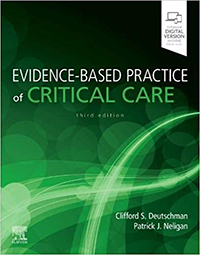
Edition 3 (2019)
Clifford Deutschman, Patrick Neligan
Approach any critical care challenge using a practical, consistent strategy based on best practices with Evidence-Based Practice of Critical Care, 3rd Edition. Unique, question-based chapters cover the wide variety of clinical options in critical care, examine the relevant research, and provide recommendations based on a thorough analysis of available evidence. Drs. Clifford S. Deutschman and Patrick J. Nelligan, along with nearly 200 critical-care experts, provide a comprehensive framework for translating evidence into practice, helping both residents and practitioners obtain the best possible outcomes for critically ill patients.
Covers a full range of critical care challenges, from routine care to complicated and special situations.
Helps you think through each question in a logical, efficient manner, using a practical, consistent approach to available management options and guidelines.
Features revised and updated information based on current research, and includes all-new cases on key topics and controversies such as the use/overuse of antibiotics, drug resistance in the ICU, non-invasive mechanical ventilation, frequency of transfusions, and duration of renal replacement therapies.
Provides numerous quick-reference tables that summarize the available literature and recommended clinical approaches.
Enhanced eBook version included with purchase. Your enhanced eBook allows you to access all of the text, figures, and references from the book on a variety of devices.
Tap into the expertise of nearly 200 critical-care experts who discuss the wide variety of clinical options in critical care, examine the relevant research, and provide recommendations based on a thorough analysis of available evidence.
Think through each question in a logical, efficient manner, using a practical, consistent approach to available management options and guidelines.
Find the information you need quickly with tables that summarize the available literature and recommended clinical approaches.
Navigate a full range of challenges from routine care to complicated and special situations.
Stay up to date with new issues and controversies such as the redefinition of sepsis • changing approaches to fluid administration • immune suppression in sepsis • monitoring the microcirculation • the long-term sequelae of critical illness • minimizing ventilator associated lung injury • the benefits of evidence-based medicine management guidelines • rapid response teams • and more.
Benefit from all-new sections covering persistent critical illness and the role of advanced practice nurses and physician assistants in the ICU.

Edition 6 (2023)
Terrence Trentman, Brantley Gaitan, Bhargavi Gali, Rebecca Johnson, Jeff Mueller, Steven Rose, Toby Weingarten
Authored by current and former physicians at the Mayo Clinic, Faust's Anesthesiology Review, 6th Edition, is an invaluable review source for success on exams and in practice. It covers a broad range of important and timely topics in a succinct, easy-to-read format, providing the essential information you need to master the latest advances, procedures, guidelines, and protocols in anesthesiology.
Provides in-depth, yet succinct clinical synopses of all topic areas found on the ABA/ASA exam, with the perfect amount of information to ensure exam success.
Contains five new chapters: Principles of Preoperative Evaluation; Anesthesia for Patients who are Lactating; Peripheral Nerve Blocks of the Anterior Trunk; Sustainability in Anesthesiology and the Operating Room; and Anesthesia During a Pandemic.
Covers the core knowledge needed to succeed in today’s anesthesiology practice, including awake craniotomy, non-OR anesthesia (NORA), neuromodulation, using arterial pressure waveform to derive cardiac output, enhanced recovery (ERAS) pathways, chemical dependency in anesthesia personnel, lung transplantation, anesthesia for robotic surgery, and more.
Includes boxes, tables, charts, and graphs throughout to provide visual guidance and summarize critical information.
Features concise chapters for efficient review and effective recall, making this an ideal study tool for certification, recertification, or as a refresher for anesthesiology practice.
An eBook version is included with purchase. The eBook allows you to access all of the text, figures and references, with the ability to search, customize your content, make notes and highlights, and have content read aloud.

Edition 6 (2021)
Jerry Zimmerman, Alexandre Rotta
In the highly specialized field of caring for children in the PICU, Fuhrman and Zimmerman's Pediatric Critical Care is the definitive reference for all members of the pediatric intensive care team. Drs. Jerry J. Zimmerman and Alexandre T. Rotta, along with an expert team of editors and contributors from around the world, have carefully updated the 6th Edition of this highly regarded text to bring you the most authoritative and useful information on today’s pediatric critical care―everything from basic science to clinical applications
Contains highly readable, concise chapters with hundreds of useful photos, diagrams, algorithms, and clinical pearls.
Uses a clear, logical, organ-system approach that allows you to focus on the development, function, and treatment of a wide range of disease entities.
Features more international authors and expanded coverage of global topics including pandemics, sepsis treatment in underserved communities, specific global health concerns by region.
Covers current trends in sepsis-related mortality and acute care after sepsis, as well as new device applications for pediatric patients.
Provides ultrasound videos and more than 500 board-style review questions and answers on Expert Consult.
Enhanced eBook version included with purchase. Your enhanced eBook allows you to access all of the text, figures, and references from the book on a variety of devices.
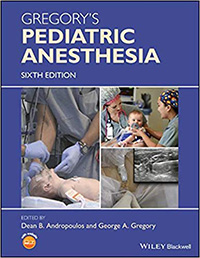
Edition 6 (2020)
George Gregory, Dean Andropoulos
As the field pediatric anesthesia advances and expands, so too does the gamut of challenges that are faced by today’s anesthesiologists. Gregory’s Pediatric Anesthesia aims to fully prepare trainees and experienced professionals for modern practice by equipping them with the knowledge and cutting-edge techniques necessary to safely and successfully anesthetize children for a range of different surgeries and other procedures. Supporting their work with current data and evidence, the authors explore topics including basic principles, potential complications, and best practice, and illustrate their findings with detailed case studies that cover all major subspecialties.
This essential new edition includes access to illustrative videos and features new and expanded sections, such as:
Anesthesia for Spinal Surgery complications including postoperative blindness
Robotic surgery for Pediatric Urological Procedures
Anesthesia for Non-Cardiac Surgery in Patients with Congenital Heart Disease (new chapter)
Extensive additional ultrasound images for regional anesthesia
Neonatal Resuscitation
The Pediatric Surgical Home and Enhanced Recovery after Surgery (new chapter)
Now in its sixth edition, Gregory’s Pediatric Anesthesia continues to provide reliable and easy-to-follow guidance to all anesthesiologists caring for younger patients.
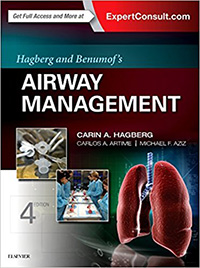
Edition 4 (2017)
Carin Hagberg
Anesthesiologists, residents, and advanced practice practitioners alike rely upon the comprehensive content of Hagberg and Benumof’s Airway Management to remain proficient in this essential area. The 4th Edition, by Drs. Carin A. Hagberg, Carlos A. Artime, and Michael F. Aziz, continues the tradition of excellence with coverage of new devices and algorithms, new research, new outcomes reporting, and much more – while retaining a concise, how-to approach; carefully chosen illustrations; and case examples and analysis throughout.
Offers expert, full-color guidance on pre- and post-intubation techniques and protocols, from equipment selection through management of complications.
Includes access to more than 25 videos online, including ultrasonography and non-invasive airway management and flexible scope intubation.
Includes the latest ASA guidelines, as well as six all-new chapters including airway management in nonoperating room locations (NORA), airway management and outcomes reporting, and more.
Features completely rewritten chapters on airway pharmacology, algorithms for management of the difficult airway, airway assessment, video-assisted laryngoscopy, and many more.
Reviews new airway devices and techniques, along with indications for and confirmation of tracheal intubation.
Brings you up to date with the latest devices, the DAS extubation algorithm, the Vortex approach, and emergency cricothyrotomy.
Expert Consult™ eBook version included with purchase. This enhanced eBook experience allows you to search all of the text, figures, and references from the book on a variety of devices.

Edition 7 (2024)
Karsten Bartels, Amanda Fox, Andrew Shaw, Kimberly Howard-Quijano, Robert Thiele
Offering a comprehensive, up-to-date overview of the field, Hensley’s Practical Approach to Cardiothoracic Anesthesia, Seventh Edition, edited by Drs. Karsten Bartels, Amanda A. Fox, Andrew D. Shaw, Kimberly Howard-Quijano, and Robert H. Thiele, is an ideal reference and review tool for fellows, residents, and practicing anesthesiologists. Concisely written and readily accessible, it combines the depth of a reference book with the no-nonsense guidance of a clinically-oriented handbook. This edition has been newly reorganized for current practice patterns and to better align with the ACGME requirements for adult cardiothoracic anesthesiology.
• Presents information in a concise, bulleted format, making it easy to read and absorb key points
• Key points are identified at the beginning of each chapter and in the margins with clinical pearls appearing throughout the text
• Provides up-to-date coverage of cardiac physiology and pharmacology, pre-procedural patient preparation, anesthetic management of specific disorders and procedures, post-procedural management, and more
• Offers the experience and expertise of three new co-editors and nearly 70 contributors from over 35 institutions
• Over 30 echocardiography clips demonstrate assessment of valve disorders, arythmias and more.
• A valuable resource for anesthesia residents, fellows in cardiac anesthesia, anesthesiology practitioners, perfusionists, and CRNAs
Edition 1 (2017)
Roger Donenfeld
This is a nice addition to the essential guides to passing your oral Anesthesia Boards. Not only is the essential information all here, but also, and perhaps more importantly, how to approach and reorganize information for a patterned and effective presentation in response to the examiner's specific questions. Learn how to give them what they want! Gives the information and techniques not often found elsewhere, tying it all together, formatting it specifically for the Anesthesia Oral Board Exam. Prepare yourself efficiently with lists, pneumonic aids, acronyms, and plain logic. This is not an exhaustive tome, but you need to know and will benefit from everything in this book. You've been in practice and you know the material. Now, learn how to show the examiners that think, communicate, and practice as a Diplomate. Others have declared: "You present an insider's guide." "I passed the first time with the help of your book!" "You de-fanged the bullies!"
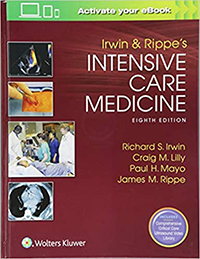
Edition 8 (2017)
Richard Irwin, Craig Lilly, Paul Mayo, James Rippe
With a focus on evidence-based, state-of-the-art information throughout, the eighth edition of Irwin and Rippe’s Intensive Care Medicine offers authoritative guidance to the wide variety of specialty physicians and non-physicians practicing in the adult intensive care environment. This comprehensive textbook covers both the theoretical and practical aspects of the field, and has been completely updated to provide encyclopedic, interprofessional coverage to support practitioners in every area of this complex field.
Features:
Approaches intensive care from an interprofessional, collaborative perspective, encompassing anesthesia, surgery, trauma, and neurology, as well as cardiovascular and medical intensive care.
Maintains a practical, clinically-oriented approach, with comprehensive sections on procedures, techniques, and ultrasound; minimally invasive monitoring; pharmacology, overdoses, and poisoning; infectious disease; transplantation; critical care consequences of agents of mass destruction; and many more.
Features many new chapters, and an entirely new section on Palliative Care and Ethical Issues in the Critical Care Unit.
Reflects the rising importance of point-of-care ultrasonography with five hours of expertly narrated video embedded into 23 relevant chapters, clearly depicting the ideal use of this tool for intensivists .
Includes a section on ICU Design, Organization, Operation, and Outcome Measures that addresses important changes and advances regarding safety, clinical practice guidelines, decreasing the cost of care, tele-ICU, and more.
Provides extensive updates reflecting advances in cardiovascular intensive care, surgical critical care, shock and trauma, and sepsis management.
Includes recommendations reflecting randomized controlled clinical trials, summarized, when possible, in quick-reference tables throughout.

Edition 8 (2024)
Joel Kaplan
Current, comprehensive, and evidence-based, Kaplan's Cardiac Anesthesia: Perioperative and Critical Care Management, 8th Edition, offers practical guidance from today’s international leaders in cardiac anesthesiology, helping you to optimize perioperative outcomes, avoid complications, and ensure maximum patient safety. Dr. Joel A. Kaplan, along with an expert team of associate editors, guides you through today’s clinical challenges, including expanded coverage of critical care, the newest approaches to perioperative assessment and management, state-of-the art diagnostic techniques, and cardiovascular and coronary physiology.
Covers the full spectrum of contemporary cardiothoracic anesthesia practice, including preoperative assessment, physiology, pharmacology, monitoring, transesophageal echocardiography, coagulation, specific cardiac procedures, extracorporeal circulation, postoperative pain treatment, and management of the complex patient with cardiac disease.
Includes expanded coverage of critical care topics, reflecting the increased perioperative care now provided by anesthesiologists in the ICU.
Contains new chapters on Structural Heart Disease Procedures; Cardiorespiratory Effects of COVID-19; Critical Care Ultrasound; Intensive Unit Management of Patients on Mechanical Circulatory Support; and Postoperative Care of the Heart and Lung Transplant Patient.
Features more than 900 full-color illustrations, decision trees, charts, and graphs (over one-third are new) that aid in visual understanding of complex topics.
Provides access to over 120 videos, including a range of echocardiography clips.
Contains balanced, dependable, and updated content on all aspects of the anesthetic management of cardiac surgical procedures, as well as cardiology procedures performed in catheterization and electrophysiologic laboratories.
Places new emphasis on cardiac devices requiring perioperative care, including cardiac implanted electrical devices and ventricular assist devices.
An eBook version is included with purchase. The eBook allows you to access all of the text, figures and references, with the ability to search, customize your content, make notes and highlights, and have content read aloud.

Edition 2 (2017)
Joel Kaplan
Practical, user-friendly, and to the point, the newly updated Kaplan’s Essentials of Cardiac Anesthesia, 2nd edition focuses on the most common topics and clinically applicable information in cardiac anesthesia today. Designed for residents, nurses, and clinicians seeking quick, high-yield answers rather than the encyclopedic information commonly found in larger references―in fact, its concise format makes it easy to complete a section in a single sitting. For an initial introduction to cardiac anesthesia, nothing compares to Kaplan’s Essentials!
Trusted authorities deliver the key cardiac anesthesia knowledge you need to know.
A concise, user-friendly format and key points boxes in each chapter help you quickly locate crucial information.
Annotated references guide you to the most practical additional resources.
A portable size and clinical emphasis facilitates and enhances bedside patient care.
Designed as a companion to Kaplan’s Cardiac Anesthesia.
Includes new topics vital to the current practice of cardiac anesthesiologists, such as transesophageal echocardiography; percutaneous valve procedures; new pacemakers and automatic internal defibrillators used for cardiac resynchronization therapy; left ventricular assist devices and extracorporeal membrane oxygenation therapy of heart failure; and patient safety issues.
Focuses on today’s most current and relevant therapies, including New Cardiac Drugs, and Heart Mate, Heart Ware, and Impella LVADs.
Describes care of the cardiac patient in Hybrid Operating Rooms, Catheterization Laboratories, and Electrophysiology Laboratories, as well as the Cardiac Operating Rooms.
Perfectly suited for residents, fellows, nurse anesthetists and anesthesiologists in practice.
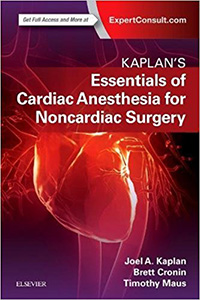
Edition 1 (2018)
Joel Kaplan, Brett Cronin, Timothy Maus
"Patients with cardiac conditions routinely present for noncardiac surgeries, requiring special protocols for perioperative assessment and management by the anesthesiologist. Essentials of Cardiac Anesthesia for Noncardiac Surgery: A Companion to Kaplan’s Cardiac Anesthesia provides current, easily accessible information in this complex area, ideal for general anesthesiologists and non-cardiac subspecialists. From preoperative assessment through postoperative care, this practical reference covers all perioperative approaches to today’s patients with cardiac conditions.
Provides guidance on the anesthetic diagnosis and management of the full range of cardiac lesions, helping minimize adverse outcomes and reduce complications for patients with common, complex, or uncommon cardiac conditions.
Includes complete coverage of echocardiography and current monitoring techniques needed for thorough perioperative assessment – all from the anesthesiologist’s perspective.
Discusses safe and effective perioperative anesthetic management of patients presenting with advanced levels of cardiac care such as drug-eluting stents, multiple antiplatelet drugs, ventricular assist devices, multiple drugs for end-stage heart failure, and implanted electrical devices that produce cardiac resynchronization therapy, as well as patients with complicated obstetric problems or other significant cardiovascular issues.
Features a concise, easy-to-navigate format and Key Points boxes in each chapter that help you find answers quickly.
Enhanced eBook version included with purchase. Your enhanced eBook allows you to access all of the text, figures, and references from the book on a variety of devices."
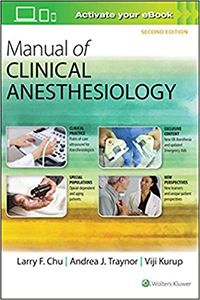
Edition 2 (2021)
Larry Chu, Andrea Traynor, Viji Kurup
Designed for rapid reference at the point of care, Manual of Clinical Anesthesiology is the clinician’s go-to resource for practical, clinically focused information on all aspects of anesthesia management. The comprehensive second edition consolidates multidisciplinary expertise in one resource, offering revised and updated content in a highly visual, portable format, with short, easy-to-read chapters, margin icons noting pearls and pitfalls, and more.
Presents information in a rapid-reference, outline format throughout, with color-coded sections, chapter summaries, pearls and pitfalls, cross-references to related text, and more.
Features new chapters on: Hemorrhage in Obstetrics, Highly Lethal Viruses (such as SARS and Ebola), Thromboelastogram/Point of Care Laboratory Interpretation, Hazards in the MRI Suite, and Substance Abuse in Medical Professionals, as well as new cognitive aids for Caudal Anesthesia, Cardiopulmonary Bypass, Ultrasound-Guided Neuraxial Anesthesia, OB Cardiac Arrest, Transthoracic Echo, and PALS.
Covers monitoring, equipment and procedures, anesthesia and comorbid diseases, pediatric anesthesia, subspecialty anesthesia, and other key topics.
Includes four full-color atlases that clearly depict procedures, transesophageal echocardiography, peripheral nerve blocks, and crisis management (including new crisis management checklists) as well as appendices of foreign language phrases and a drug dosing pull-out card.
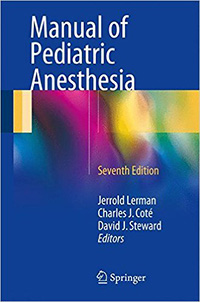
Edition 7 (2016)
Jerrold Lerman, David Steward, Charles Cote
Authored by three world experts, this is a clinically focused book on pediatric anesthesia. "The Manual", as it is known, has long dominated the market for a succinct and practical resource on administering anesthesia to children and is used by residents, general anesthesiologists, nurse anesthetists, and pediatric anesthesiologists. This new edition retains the basic structure of the book and is updated throughout. Text-heavy in the current edition, the Seventh Edition features the addition of figures to chapters where they are especially helpful (eg, the chapter on cardiovascular surgery and cardiac procedures) and makes greater use of headings to break up the text and guide reading. From reviews of the Sixth Edition:"This is an extremely well written book that I would recommend highly to anyone involved in anaesthetizing children. It is comprehensive enough to provide an excellent reference for trainees and general anaesthetists who occasionally deal with paediatric cases, while at the same time giving valuable supplemental information for paediatric anaesthetists encountering an unusual procedure or condition. In short, this is a book that would make a welcome addition to any anaesthetist's mobile library." --Anaesthesia
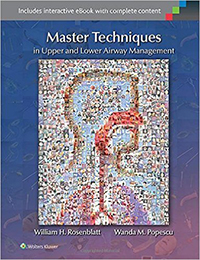
Edition 1 (2015)
William Rosenblatt, Wanda Popescu
Overcome the toughest airway challenges with Master Techniques in Upper and Lower Airway Management! Under the preeminent editorial guidance of William Rosenblatt, MD and Wanda Popescu, MD, a multitude of expert anesthesiologists guide you through all the ins and outs of managing difficult airways. This anesthesiology reference’s case-based approach demonstrates the clinical applications of important principles, and a large collection of online videos shows you how to perform key techniques successfully.
“Two master clinician educators, Drs. William Rosenblatt and Wanda Popescu, calling on their expertise in airway management and thoracic anesthesia, respectively, have developed a unique book which explores the pathway of the airway from lips (nares) to the terminal bronchi to develop a highly focused volume with accompanying e-media to highlight clinical management. Although the organization of the book may seem obvious or intuitive, this is the first time a textbook has been developed in this manner. For the reader, these individuals have assembled the ‘go to faculty’ for both pre-operative consultation, as well as, intra-operative airway related events in their specialties.”
– from the Foreword by Paul G. Barash MD
Key Features:
Be prepared to tackle a complete range of upper airway problems with comprehensive coverage of everything from evaluation and basic management of the difficult upper airway patient, through pre-existing conditions • otolaryngology and maxillofacial procedures • nasal intubation, tracheostomy, and foreign bodies • pediatric patients • the at-risk cervical spine • extubation, and more, as well as lower airway issues including interventional pulmonology • lung isolation devices and techniques • airway surgery • surgeries requiring lung isolation • congenital abnormalities of the lower airway • lung transplantation • lower airway emergencies • and more.
Apply principles in practice by reviewing case histories that show concrete applications in the context of managing real patients. Then challenge your decision making with case-based questions and answers that delve into the details that lead to optimal outcomes.
Master vital nuances of technique by watching a large collection of online videos derived from more than 700 actual patients.
Now with the print edition, enjoy the bundled interactive eBook edition, offering tablet, smartphone, or online access to:
Complete content with enhanced navigation
A powerful search that pulls results from content in the book, your notes, and even the web
Cross-linked pages, references, and more for easy navigation
Highlighting tool for easier reference of key content throughout the text
Ability to take and share notes with friends and colleagues
Quick reference tabbing to save your favorite content for future use
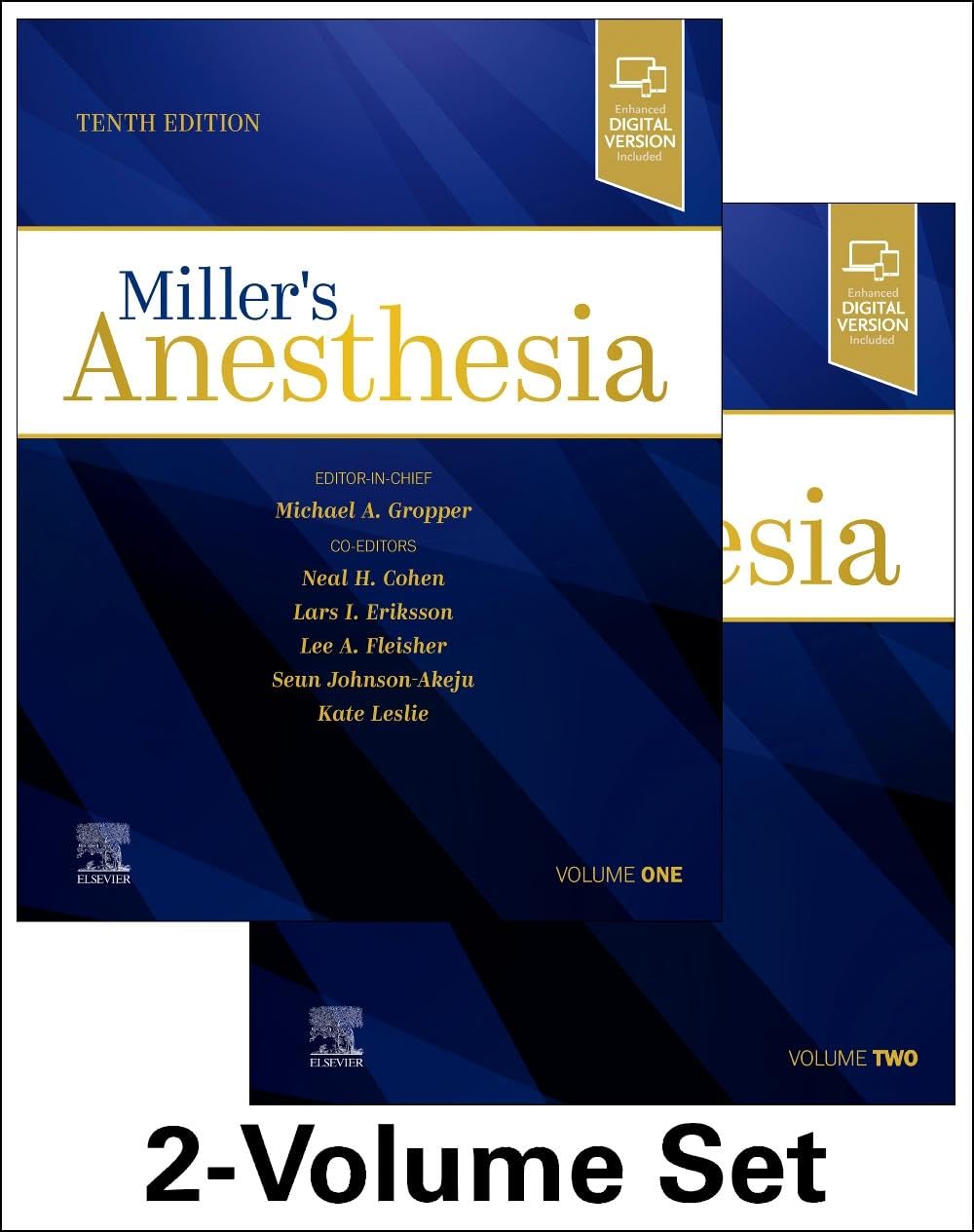
Edition 10 (2024)
Michael Gropper, Neal Cohen, Lars Eriksson, Lee Fleisher, Seun Johnson-Akeju, Kate Leslie
Offering up-to-date coverage of everything from historical and international perspectives to basic science and today’s clinical practice, Miller's Anesthesia, 10th Edition, remains the #1 reference and trusted learning resource for practitioners and trainees in this complex field. Dr. Michael Gropper leads a team of expert editors and contributing authors who provide current information on the technical, scientific, and clinical issues you face each day―whether you’re managing a challenging patient care situation, preparing for the boards, or studying for recertification.
Addresses timely topics alongside foundational basic science for an in-depth and comprehensive understanding of the field.
Contains thoroughly up-to-date content, including two new chapters: The Immune System: Implications for Anesthetic Management and Emergency Preparedness in Healthcare.
Provides new content in key areas such as sustainability, global health equity, the effect of anesthetics on immune function, anesthesia for special populations, coverage of infectious diseases including COVID-19, and occupational exposure and safety.
Offers state-of-the-art coverage of anesthetic drugs, guidelines for anesthetic practice and patient safety, new techniques, step-by-step instructions for patient management, the unique needs of pediatric patients, and much more―all highlighted by more than 1,200 full-color illustrations (300 new to this edition) for enhanced visual clarity.
Includes 40+ video clips demonstrating patient positioning, ultrasound, echocardiograms, and other imaging, and anesthetic procedures in real time.
An eBook version is included with purchase. The eBook allows you to access all of the text, figures and references, with the ability to search, customize your content, make notes and highlights, and have content read aloud. Additional digital ancillary content may publish up to 6 weeks following the publication date.
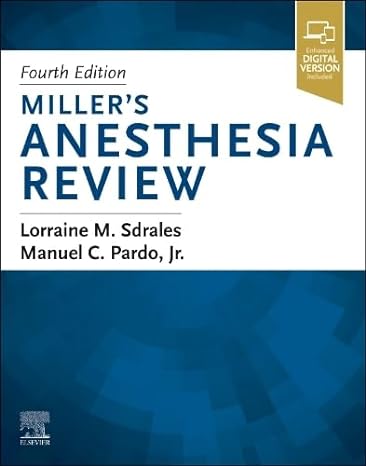
Edition 4 (2024)
Lorraine Sdrales, Manuel Pardo
Covering all anesthesia topics from basic to advanced, Miller's Anesthesia Review, 4th Edition, is an ideal resource for self-assessment and deepening your understanding of this ever-expanding and challenging field. Edited by Drs. Lorraine M. Sdrales and Manuel C. Pardo, Jr., this authoritative guide provides high-yield study points in an easy-to-read, bulleted format, along with hundreds of questions, answers, and rationales to help you test your knowledge and identify knowledge gaps for further study. Conveniently cross-referenced to the latest edition of Miller’s Basics of Anesthesia, it covers everything from physiologic and pharmacologic principles through anesthetic machine systems, anesthetic delivery in a variety of settings, and anesthesia administration for a full range of disease states.
Uses an efficient, bulleted outline format for each chapter, summarizing core content and providing self-test questions and workbook tasks that test your conceptual knowledge and rationale.
Brings you fully up to date with revised questions throughout, progressing logically from basic to advanced topics.
Includes selected figures, tables, and clinical pearls boxes to emphasize key concepts.
Features new chapters that reflect the breadth and scope of the practice of anesthesiology, including Clinician Well-Being, Perioperative Point-of-Care Ultrasound, Environmental Impact of Anesthesia, and Perioperative Medicine.
Provides up-to-date coverage of hot topics such as anesthesia neurotoxicity, sleep medicine, and more.
Corresponds to Miller’s Basics of Anesthesia to help you make the most of your study time, learn more efficiently, and pursue further information if needed.
Ideal for anesthesia providers of all levels, from new learners to more experienced practitioners.
An eBook version is included with purchase. The eBook includes interactive multiple-choice questions, and allows you to access all of the text, figures, and references, with the ability to search, customize your content, make notes and highlights, and have content read aloud. Any additional digital ancillary content may publish up to 6 weeks following the publication date.
Edition 1 (2019)
John Butterworth, David Mackey, John Wasnick
A clinically relevant, case-based review of anesthesiology – based on the field’s cornerstone text
Includes link to video clips demonstrating key procedures
Essential for written and oral board preparation, here is a new case-based companion to Morgan and Mikhail’s Clinical Anesthesiology, Sixth Edition textbook. The book includes approximately 300 brief case descriptions, with each case followed by a series of board-style Q&A. These cases are organized to match the content of the parent text to facilitate side-by-side study. With case-based learning now pervasive in training for all medical specialties, especially anesthesiology, Morgan & Mikhail’s Clinical Anesthesiology Cases fills a void in medical publishing. This unique resource is also valuable as a clinical refresher before the Operating Room.
Edition 1 (2024)
Richard Urman, Patricia LaMontagne
A high-yield, abridged version of the bestselling guide to general anesthesia and perioperative medicine
Drawing from the trusted classic, Morgan and Mikhail's Clinical Anesthesiology Handbook has been pared down to the most essential information needed by anesthesia practitioners.
The Handbook provides condensed, practical content relevant to clinical anesthesiology practice, covering topics within preoperative, intraoperative, and postoperative care. Many tables and figures have been retained from the larger textbook. This new abridged resource serves as a high-yield review of the core content of the larger text, with bolded key concepts for ease of reference, Q&A, and more.
• Convenient, abridged version―less than half the length of origin text
• Ideal resource for residents and trainees preparing for daily activity
• High-yield review with variety of review techniques, including Q&A
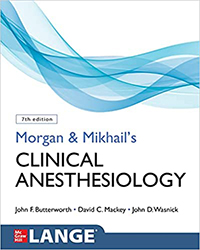
Edition 7 (2022)
John Butterworth, David Mackey, John Wasnick
he most engagingly written, clinically relevant overview of the practice of anesthesiology
Morgan & Mikhail’s Clinical Anesthesiology, Seventh Edition is an essential resource for all anesthesia students and practitioners. Hailed as the best primer on the topic, this trusted classic delivers comprehensive coverage of the field’s must-know basic science and clinical topics in a clear, easy-to-understand presentation. The text is also ideal for coursework, review, or as a clinical refresher.
Key features that make it easier to understand complex topics:
Rich full-color art work combined with a modern, user-friendly design make information easy to find and remember
The perfect distillation of essential information: succinct without sacrificing important details
Case discussions promote application of concepts in real-world clinical practice
Key Concepts at the beginning of each chapter identify important issues and facts
Numerous tables and figures encapsulate important information and facilitate recall
Up-to-date discussion of all relevant areas of anesthesiology, including equipment and monitors, pharmacology, pathophysiology, regional anesthesia, pain management, and critical care
URLs for societies, guidelines, and practice advisories
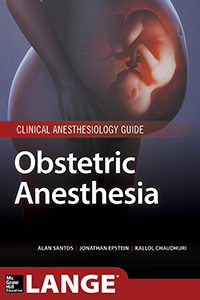
Edition 1 (2015)
Alan Santos, Jonathan Epstein, Kallol Chaudhuri
Understand the anesthetic management challenges of the obstetric patient with this complete primer and review
Obstetric Anesthesia is a clear, concise, and practical manual covering the basics of obstetric anesthesiology and the principles of basic management at the point of care. This essential introductory text covers the fundamental topics in an efficient and highly clinical manner. Numerous tables, bulleted lists, and text boxes highlight key issues such as common co-existing diseases and conditions that may affect anesthetic management.
Obstetric Anesthesia features thirty chapters grouped into six logical sections:
Pregnancy
Providing Anesthesia
Anesthetic Complications
Obstetric Complications
Common Co-Morbidities During Pregnancy
Trauma During Pregnancy
Enriched by contributions from practicing obstetrical anesthesiologists and renowned instructors, Obstetric Anesthesia includes the most up-to-date practice guidelines. It is a valuable clinical refresher and an outstanding board review.
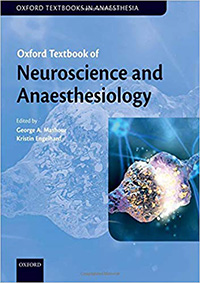
Edition 1 (2019)
George Mashour, Kristin Engelhard
The perioperative care of individuals with neurologic compromise is critically important, yet it is only one dimension of the rich relationship between anaesthesiology and the neurosciences. The mechanism of everyday therapeutic interventions such as anaesthesia and analgesia is exciting neuroscience in its own right. At the new frontier of outcomes studies lies the question of how the perioperative period might impact the brain. For example, questions related to anaesthetic neurotoxicity, delirium, and cognitive dysfunction pose critical challenges for the field.
The Oxford Textbook in Neuroscience and Anaesthesiology addresses the exciting field of neuroanaesthesiology in a new and stimulating way. In twenty eight chapters, the neuroscientific basis of anaesthesiology, the full spectrum of clinical neuroanaesthesia, and the care of neurologic patients undergoing non-neurologic surgery are explored in one comprehensive textbook for the first time.
The first section considers the neural mechanisms of general anaesthetics, cerebral physiology, the neurobiology of pain, and more. The second section explores the care of patients with neurologic disease in the operating room or intensive care unit. These clinical chapters systematically treat the perioperative considerations of both brain and spine surgery, and provide introductions to neurocritical care and pediatric neuroanaesthesia. The final section outlines the care of neurologic patients undergoing non-neurologic surgery. It examines key connections of neurology and anaesthesiology, examining how conditions such as dementia, stroke, or epilepsy interface with the perioperative period.
Each chapter has been carefully crafted to be concise yet highly informative, reflecting the cutting edge of neuroscience and neuroanaesthesiology. This international textbook gathers the best available expertise of authors and leaders worldwide. Includes access to online-only content, including more than 20 cases and more than 90 questions that can be used in presentations and teaching sessions. By activating your unique access code, you can access and use the material.
Edition 1 (2015)
T. Anthony Anderson, Kai Matthes, Anjolie Laubach, Ellen Wang
Pediatric Anesthesiology: A Comprehensive Board Review is a high-yield, streamlined study aid. It contains more than 800, realistic, multiple-choice questions tailored to the keywords in the outline of the Pediatric Anesthesiology Certification Examination published by the American Board of Anesthesiology (ABA). To maximize reading efficiency, annotated answers are followed by bulleted key facts and key references. With this book as guide, readers will be able to efficiently prepare for the written primary certification pediatric anesthesiology board exam.
Edition 3 (2021)
Robert Holzman, Thomas Mancuso, Joseph Cravero, James DiNardo
This book functions as a workbook for consultants in pediatric anesthesia. Based on a curriculum developed at the Boston Children’s Hospital Department of Anesthesiology, the content illustrates the breadth and depth of the practice of pediatric anesthesia.
Organized into two parts, the book seeks to provide a sense of progression and feedback using clinical scenarios to aid the medical professional in developing autonomy, while preserving the availability of expert level discussion. Each chapter features self-assessments in question and answer format, and encourages the reader to be creative in their responses by invoking not only their clinical knowledge, but their philosophical views of pediatric anesthesia practice as well.
Practical and accessible, The Pediatric Anesthesiology Review is an essential resource for those looking to attain proficiency, expertise, and mastery in pediatric anesthesiology.

Edition 2 (2021)
Mark Newman, Lee Fleisher, Clifford Ko, Michael Mythen
Based on the most current evidence and best practices, Perioperative Medicine: Managing for Outcome, 2nd Edition, is an easy-to-follow, authoritative guide to achieving optimal outcomes in perioperative care. Written and edited by recognized authorities in anesthesiology and surgical critical care, this fully updated edition helps you think critically about complex, long-term issues surrounding the care of the surgical patient, providing decision trees that define strategies to enhance the medical outcome of care.
Focuses on what anesthesiologists, surgeons, and intensivists need to know in order to improve outcomes through evidence- and outcome-based approaches.
Provides practical guidance on potential risks to all major organ systems, the etiology of particular organ dysfunctions, preoperative and intraoperative risk factors, and perioperative protection strategies to minimize potential complications.
Features a consistent chapter format - with even more color-coded algorithms, summary tables, and boxes – that enables you to quickly explore and determine the best management approaches.
Includes six all-new chapters: Perioperative Fluid Management; Delirium and POCD; Role of Palliative Care/ICU; Value-Based Care: The UK Model; CFO Perspective on Value; Hospital to Home (Perioperative Transitions of Care)
Discusses timely topics such as quality improvement, pay-for-performance, preexisting disease and comorbid conditions in anesthesiology, and the team-based model of care.

Edition 2 (2018)
Annette Vegas
Transesophageal echocardiography (TEE) is a valuable diagnostic modality now routinely used during cardiac surgery and in the intensive care unit. Increasingly, anesthesiologists, cardiologists and critical care physicians trained in TEE provide the service in both settings where they face the challenge of integrating numerous current TEE guidelines into day-to-day practice. Perioperative Two-Dimensional Transesophageal Echocardiography: A Practical Handbook, 2nd Edition has been designed to be a concise, portable guide for using TEE to recognize cardiac pathology during the perioperative period.
This compact guide has a diverse appeal for anesthesiologists, cardiac surgeons and cardiologists desiring comprehensive up-to-date echocardiographic information at their fingertips.
Features
Updated to include 4 new chapters
Now contains more than 600 full-color, high quality clinical images and illustrations
Includes the most recent guidelines
Retains a compact format that highlights key information
Synopsis of cardiac pathology commonly encountered in cardiac surgery patients
On-the-spot reference for echocardiographers with a wide range from novice to expert experience
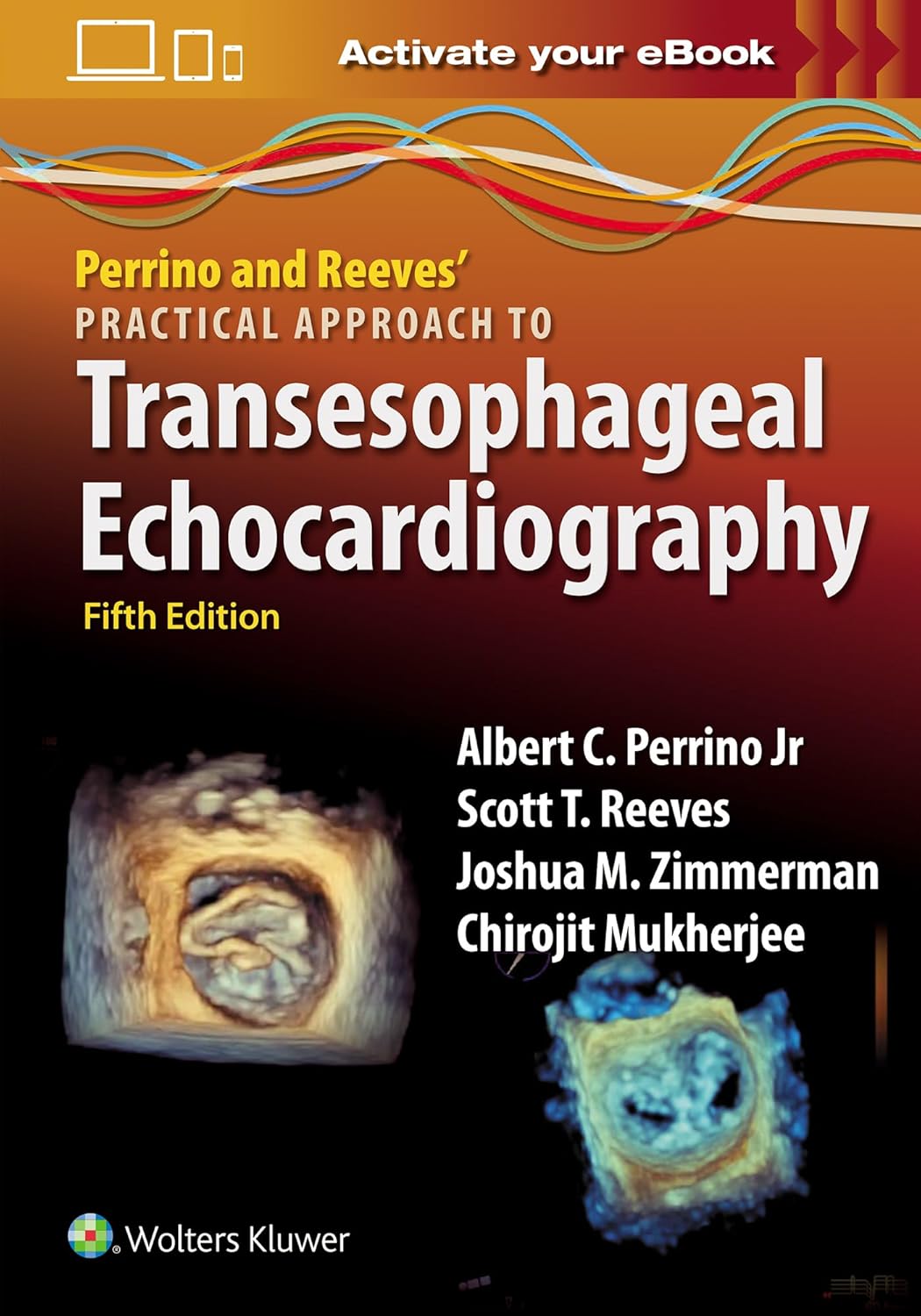
Edition 5 (2025)
Albert Perrino Jr., Chirojit Mukherjee, Joshua Zimmerman
Covering both the science behind transesophageal echocardiography (TEE) and its uses for monitoring and diagnosis, Perrino and Reeves’ Practical Approach to Transesophageal Echocardiography, Fifth Edition, provides the information you need for all levels of transesophageal echocardiography usage and testing. Expertly edited by Drs. Albert C. Perrino, Jr, Scott T. Reeves, Joshua M. Zimmerman and Chirojit Mukherjee, this concisely written manual features numerous figures and review questions in every chapter, allowing you to quickly digest and apply critical information in actual clinical settings.
Covers key topics such as 2D imaging, Doppler echo, valvular disease, and specific clinical challenges
Features more than 300 end of chapter multiple-choice review questionswith answers and rationales as well as over 400 clinical and procedural video clips.
Discusses common artifacts and pitfalls, as well as techniques and tricks for optimizing TEE images
Contains valuable appendices covering cardiac cross section criteria, cardiac dimensions, hemodynamic calculations, valve prostheses, and more
Shares the knowledge and expertise of two new editors: Joshua Zimmerman of the University of Utah School of Medicine and Chirojit Mukherjee of Helios Park Clinic in Germany
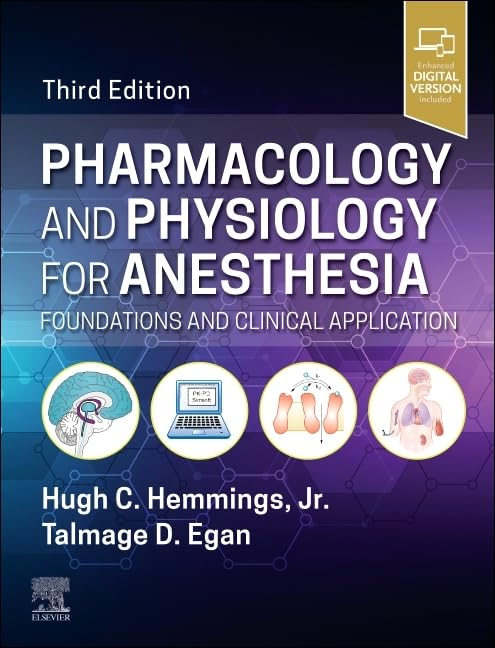
Edition 3 (2026)
Hugh Hemmings, Talmage Egan
An ideal resource for study, review, and successful anesthesiology practice, Pharmacology and Physiology for Anesthesia, 3rd Edition, provides the foundational information in pharmacology, physiology, and molecular-cellular biology to staycurrent with contemporary practice. This fully updated edition is invaluable for anesthetists and intensivists in perioperative patient management, offering a one-stop, detailed overview of the physiological and pharmacological principles underlying anesthesia―including clinical applications―helping you make informed decisions on anesthetic drug selection and administration, physiological management, and treatment of common disease in the perioperative period.
Covers the normal and pathologic physiology affected by anesthetic interventions in surgical and critical care environments, including comprehensive information on anesthesia- related pharmacology such as drug mechanisms, pharmacokinetics, pharmacodynamics, pharmacogenetics, and pharmaceutical chemistry
Reflects recent advances in the field such as new coagulation therapies, target controlled infusion (TCI) technology, pharmacogenomics, and glucagon-like-peptide-1 (GLP-1) agonists and their implications for anesthesia practice
Includes significantly expanded chapters on blood management and hemostasis, and the pharmacology of intravenous anesthetics, antihypertensive agents, and anti-arrhythmic drugs, with a full chapter dedicated to the essential anesthetic propofol
Helps you understand the molecular mechanisms of drug actions and identify key drug interactions that can complicate anesthesia with sections dedicated to these areas
Features user-friendly tables, illustrations, diagrams, figures, and algorithms, all presented in full color and designed to help explain complex concepts
An eBook version is included with purchase. The eBook allows you to access all of the text, figures, and references, with the ability to search, customize your content, make notes and highlights, and have content read aloud
Thoroughly updated covering the new drugs and how they interact with various organ systems, including their molecular mechanisms and any key drug interactions the anesthesiologist needs to be aware of

Edition 5 (2024)
Richard Urman, Jesse Ehrenfeld
Designed for portability and quick reference, Pocket Anesthesia, Fifth Edition, provides the essential information needed by practitioners and trainees on a daily basis. Expertly edited by Drs. Richard D. Urman and Jesse M. Ehrenfeld, this fully updated volume provides a concise and focused review of all areas of anesthesiology in one easy-to-navigate, pocket-sized notebook, making it an ideal reference for residents, anesthesiologists, CRNAs, CAA’s and students, in all clinical settings where anesthesia care is delivered.
Follows the bestselling, looseleaf Pocket Notebook format, featuring bulleted lists, tables, diagrams, and algorithms that make essential facts easy to find and retain
Contains fully updated core clinical topics on patient evaluation; pharmacology; airway management; regional anesthesia, POCUS, perioperative monitoring, ventilation techniques, acute and chronic pain management, ERAS, trauma and critical care management, pediatric and geriatric anesthesia, and much more
Provides helpful appendices on formulae for quick reference, setting up the OR, management of malignant hyperthermia, and more
Features new and expanded chapters on Burn Management, Infection Control and Respiratory Illness Considerations (including COVID-19), Optimizing the Anesthesia Care Team
Contains current, evidence-based clinical recommendations

Edition 3 (2019)
David Sidebotham, Alan Merry, Malcolm Legget, Gavin Wright
Practical Perioperative Transoesophageal Echocardiography, Third Edition, is the definitive guide dedicated to helping clinicians use this essential imaging technique to manage perioperative cardiac patients.
Capturing the latest evidence-based developments; this resource offers authoritative guidance on monitoring and procedures for cardiac anaesthetists and intensivists. International expert authors help you apply this knowledge via clear step-by-step techniques with a focus on problem-solving and safe practice.
Extensively illustrated itself, the book comes with online access to even more content: over 670 videos with corresponding annotated still frames, plus you can test your knowledge by answering over 145 self-assessment questions.
This guide teaches you exactly what you need to know by covering the curriculum for the British Society of Echocardiography accreditation in Transoesophageal Echocardiography (BSE) and the European Association of Cardiothoracic Anaesthetists/European Society of Echocardiography TOE accreditation examination (EACTA), and the US-based PTEeXAM.
An essential reference and interactive guide, this unique book should never be far from the cardiac anaesthetist's side.
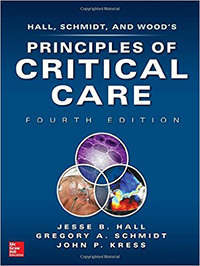
Edition 4 (2015)
Jesse Hall, Gregory Schmidt, John Kress
Quickly and accurately diagnose and treat the critically ill patient with guidance from the field's definitive text
"…Clearly the finest textbook available in the field." -- Critical Care Medicine journal
"…Very well done…unusually user-friendly…excellent…a significant contribution to the field. It should be placed not only in the critical care practitioner's library, but also in the rounds and nurses' conference rooms of critical care units." -- Journal of the American Medical Association
Considered the field's definitive text, Principles of Critical Care offers unmatched coverage of the diagnosis and treatment of the most common problems encountered in the practice of critical care. Written by expert critical care physicians who are also experienced teachers, the book features an organization, thoroughness, and clarity not found in any other reference on the topic. Within its pages, you will find comprehensive, authoritative discussion of every aspect of critical care medicine essential to successful clinical practice, ranging from basic principles to the latest technologies.
The fourth edition is highlighted by:
A new full-color presentation
NEW CHAPTERS on ICU Ultrasound, Extracorporeal Membrane Oxygenation, ICU-Acquired Weakness, Abdominal Compartment Syndrome, and Judging the Adequacy of Intravascular Volume
The addition of many new figures and diagnostic and treatment algorithms
In-depth, up-to-date descriptions of the unique presentation, differential diagnosis, and management of specific critical illnesses
A logical organ system approach that simplifies the search for thorough and practical information necessary to manage a patient’s specific condition
The integration of pathophysiology throughout the text
Content that reflects today’s interdisciplinary approach to critical care medicine
*Reviews are of previous editions
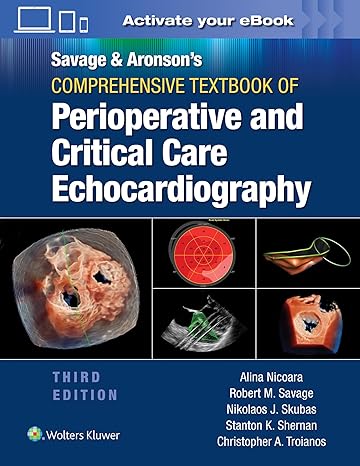
Edition 3 (2022)
Robert Savage, Solomon Aronson, Stanton Sherman, Nikolaos Skubas, Alina Nicoara, Christopher Troianos
Thoroughly revised to reflect new advances in the field, Savage & Aronson’s Comprehensive Textbook of Perioperative and Critical Care Echocardiography, Third Edition, remains the definitive text and reference on transesophageal echocardiography (TEE). Edited by Drs. Alina Nicoara, Robert M. Savage, Nikolaos J. Skubas, Stanton K. Shernan, and Christopher A. Troianos, this authoritative reference covers material relevant for daily clinical practice in operating rooms and procedural areas, preparation for certification examinations, use of echocardiography in the critical care setting, and advanced applications relevant to current certification and practice guidelines.
Contains significantly expanded content on the use of TEE and transthoracic echocardiography (TTE) in the critical care setting—more than twice the material offered in the previous edition and ideal for Critical Care Echocardiography certification preparation
Features new chapters on transcatheter procedures
Includes up-to-date information on organizing education and training in perioperative echocardiography and on ultrasound for vascular access, assessment of the patient with endocarditis and using echo during resuscitation, epiaortic and epicardial imaging; endovascular management of thoracic vascular disease, transcutaneous management of valvular heart disease, and more
Chapters provide key point summaries and review questions and answers throughout, making it an excellent tool for study and review
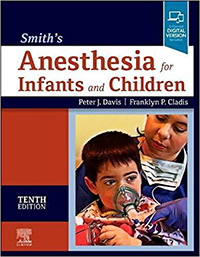
Edition 10 (2021)
Peter Davis, Franklyn Cladis
Written and edited by renowned experts in pediatric anesthesia, Smith's Anesthesia for Infants and Children provides clear, concise guidance on effective perioperative care for any type of pediatric surgery. The 10th Edition contains significantly revised content throughout, bringing you fully up to date with recent advances in clinical and basic science that have led to changes in today’s clinical practice.
Offers comprehensive coverage of physiology, pharmacology, and clinical anesthetic management of infants and children of all ages.
Contains new chapters on Airway Physiology and Development, Normal and Difficult Airway Management, Ultrasound, Acute Pain Management, Chronic Pain Management, Palliative Pain Management, Infectious Diseases, and Education; plus extensively revised content on cardiovascular physiology; induction, maintenance, and recovery; organ transplantation, and more.
Features more than 100 video demonstrations, including regional anesthesia videos, echocardiograms of congenital heart lesions, anatomic dissections of various congenital heart specimens with audio explanations, various pediatric surgical operative procedures, airway management, and much more.
Provides outstanding visual guidance throughout, including full-color photographs, drawings, graphs and charts, and radiographic images.
Includes quick-reference appendices online: drug dosages, growth curves, normal values for pulmonary function tests, and a listing of common and uncommon syndromes.
Provides an interactive question bank online for review and self-assessment.
Enhanced eBook version included with purchase. Your enhanced eBook allows you to access all of the text, figures, and references from the book on a variety of devices.
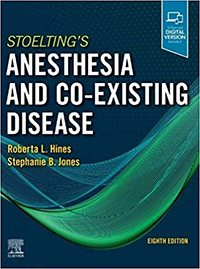
Edition 8 (2021)
Roberta Hines, Stephanie Jones
A valuable resource for anesthesia providers at all levels of training and practice, Stoelting's Anesthesia and Co-Existing Disease, 8th Edition, provides concise, thorough coverage of pathophysiology of the most common diseases and their medical management relevant to anesthesia. Noted authority Dr. Roberta L. Hines and new editor Dr. Stephanie Jones lead a stellar team of contributing authors who provide clear, detailed guidance on successfully managing or avoiding complications stemming from pre-existing conditions.
Presents detailed discussions of common diseases, as well as highlights of more rare diseases and their unique features that could be of importance in the perioperative period.
Includes the latest practice guidelines, easy-to-follow treatment algorithms, bulleted key points, and more.
Contains two new chapters on Nutritional Diseases: Obesity and Malnutrition and Chronic Pain, and significantly revised content on valvular heart disease, heart failure and cardiomyopathies, pericardial disease and cardiac trauma, endocrine disease, diseases of aging, pregnancy-associated diseases, and more.
Features abundant figures, tables, diagrams, and photos that provide fast access to the most pertinent aspects of every condition and clarify critical points regarding management.
Examines specific anesthesia considerations for special patient populations, including pediatric, obstetric, and elderly patients.
Ideal for anesthesiologists in practice and for anesthesia residents in training and preparing for boards.
Enhanced eBook version included with purchase. Your enhanced eBook allows you to access all of the text, figures, and references from the book on a variety of devices.
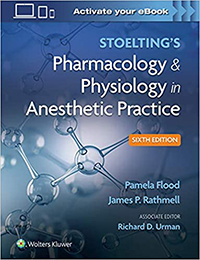
Edition 6 (2021)
Pamela Flood, James Rathmell, Richard Urman
Comprehensive, readable, and clinically oriented, Stoelting’s Pharmacology & Physiology in Anesthetic Practice, Sixth Edition, covers all aspects of pharmacology and physiology that are relevant either directly or indirectly to the anesthetic practice—a challenging topic that is foundational to the practice of anesthesia and essential to master. This systems-based, bestselling text has been thoroughly updated by experts in the field, giving you the detailed information needed to make the most informed clinical decisions about the care of your patients.
Offers trainees and practitioners authoritative content on all aspects of pharmacology and physiology that are relevant to anesthesiology.
Features up-to-date coverage of new drugs, as well as new findings on the actions and interactions of established drugs.
Discusses antimicrobials and chemotherapeutic drugs, as well as special populations such as the newborn, the parturient and fetus, the elderly, and the physiology and pharmacology of resuscitation.
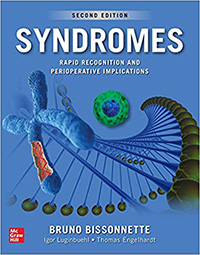
Edition 2 (2019)
Bruno Bissonnette, Igor Luginbuehl, Thomas Engelhardt
Your one-stop resource for all major genetic syndromes and important anesthetic, diagnostic, and pharmacological considerations
4 STAR DOODY'S REVIEW!
"This is a nearly exhaustive compilation of over 4,500 pediatric syndromes and their impact on perioperative management....I have not come across a book that covers this subject as completely and makes referencing as easy as this one does. It is truly an essential text for those providing operative care to children who have syndromic diseases."--Doody's Review Service
The ultimate desk reference for anesthesiologists, pediatricians, geneticists, and internists, Syndromes provides convenient A-Z coverage of more than 2,000 genetic, metabolic, and dysmorphic conditions. Extensive cross-referencing of synonyms, variations, and international names leads to over 4,500 entries in all!.
An encyclopedic dictionary of every genetic syndrom known to humankind
Includes synonyms, variations and international names--more than 4,500 cross-referenced syndromes in all
180 photographs illustrate manifestations and common presentations
Standardized, two-column rapid retrieval template
For each syndrome, from Aarskog to Zellweger Syndrome, you'll find a succinct "snapshot" of clinical information that includes:
"At a Glance" Description
Incidence
Genetic Inheritance
Pathophysiology
Diagnosis
Clinical Aspects
Precautions before Anesthesia
Anesthetic Considerations
Pharmacological Implications
Other Conditions to be Considered
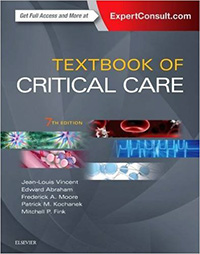
Edition 7 (2016)
Jean-Louis Vincent, Edward Abraham, Patrick Kochanek, Frederick Moore, Mitchell Fink
Comprehensive, concise, and readable, Textbook of Critical Care, 7th Edition, brings you fully up to date with the effective management of critically ill patients, providing the evidence-based guidance you need to overcome a full range of practice challenges. Drs. Jean-Louis Vincent, Edward Abraham, Frederick A. Moore, Patrick Kochanek, and Mitchell P. Fink are joined by other international experts who offer a multidisciplinary approach to critical care, sharing expertise in anesthesia, surgery, pulmonary medicine, and pediatrics. This highly acclaimed text offers ICU clinicians a new understanding of the pathophysiology of critical illness and new therapeutic approaches to critical care.
Features a wealth of tables, boxes, algorithms, diagnostic images, and key points that clarify important concepts and streamline complex information for quick reference.
Includes procedural videos online.
Expert Consult™ eBook version included with purchase. This enhanced eBook experience allows you to search all of the text, figures, and references from the book on a variety of devices.
Includes many new chapters on echocardiography, antibiotic stewardship, antiviral agents, coagulation and anti-coagulation, , telemedicine, extracorporeal membrane oxygenation (ECMO), and more.
Offers new coverage of biomarkers, bedside ultrasound, and the management of increasingly complex critically ill patients.
Provides new approaches to sepsis, acute kidney injury, and management of acute respiratory distress syndrome (ARDS), and other forms of respiratory failure.
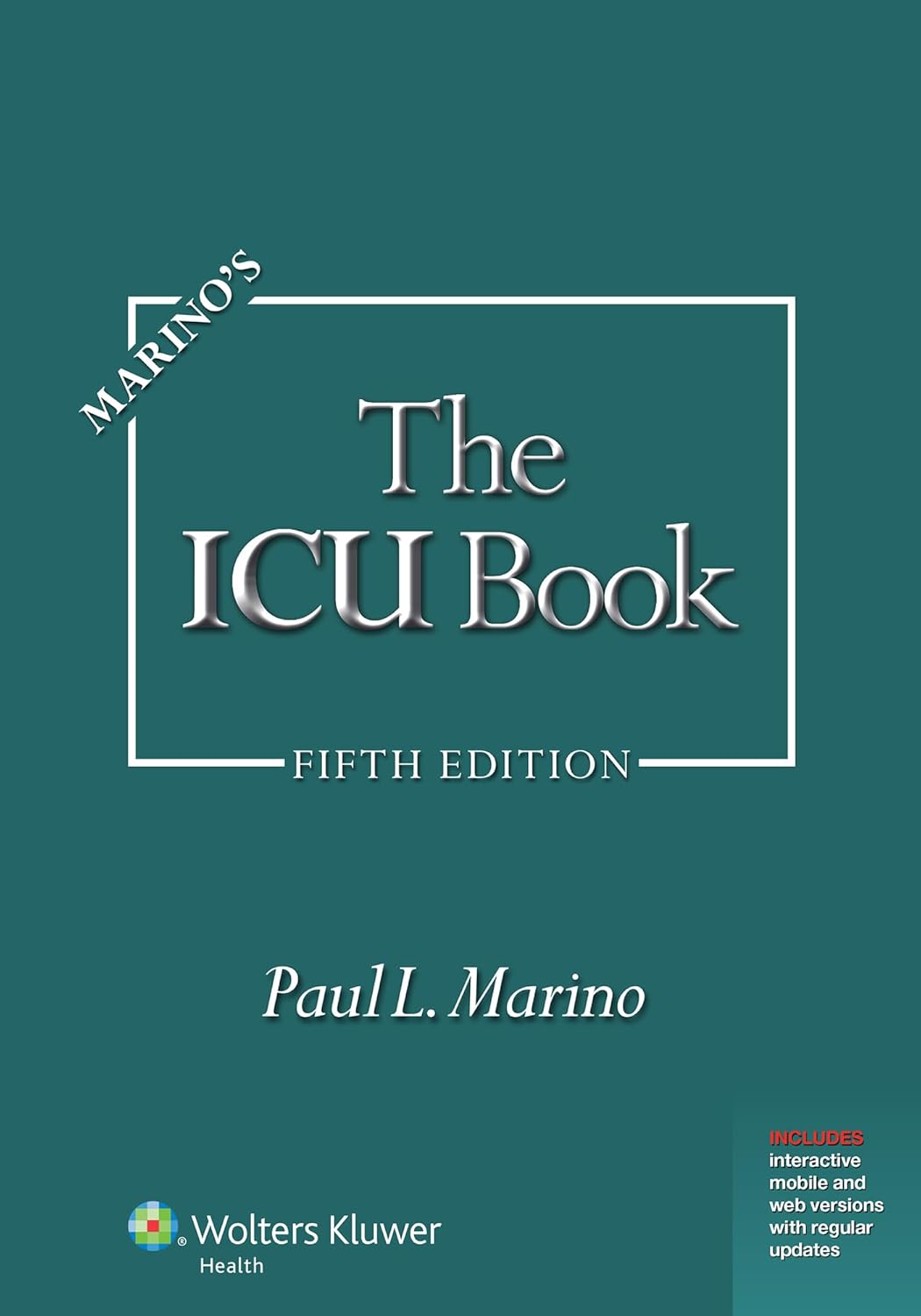
Edition 5 (2024)
Paul Marino
Dr. Paul L. Marino’s concise, engaging writing style is just one of many reasons that Marino’s The ICU Book is the best-selling reference in critical care. This highly regarded, full-color resource contains the essential information needed to care for patients in any ICU, regardless of the specialty designation of the unit. The newly revised Fifth Edition continues the focus on practical aspects of patient care and will appeal to anyone with an interest in the care of critically ill patients. The intended audience incudes medical students, interns and residents in medicine, surgery, and anesthesiology, critical care physicians and nurses, physician’s assistants, respiratory therapists, and paramedics.
Dr. Marino has been a practicing critical care specialist for 44 years, and the material in his book is a reflection of this vast experience.
The text has been completely rewritten and incorporates the latest concepts and most recent clinical practice guidelines.
Because this is a single-author text, the writing and style are consistent from chapter to chapter, and redundancies are held to a minimum.
New chapters have been added on fluid management, approaches to clinical shock, acute pulmonary embolism, liver failure, and acute pancreatitis.
As in prior editions, there are numerous illustrations and tables that highlight the material in the text, and each chapter ends with a section called “A Final Word” that presents a take-home message from the chapter.
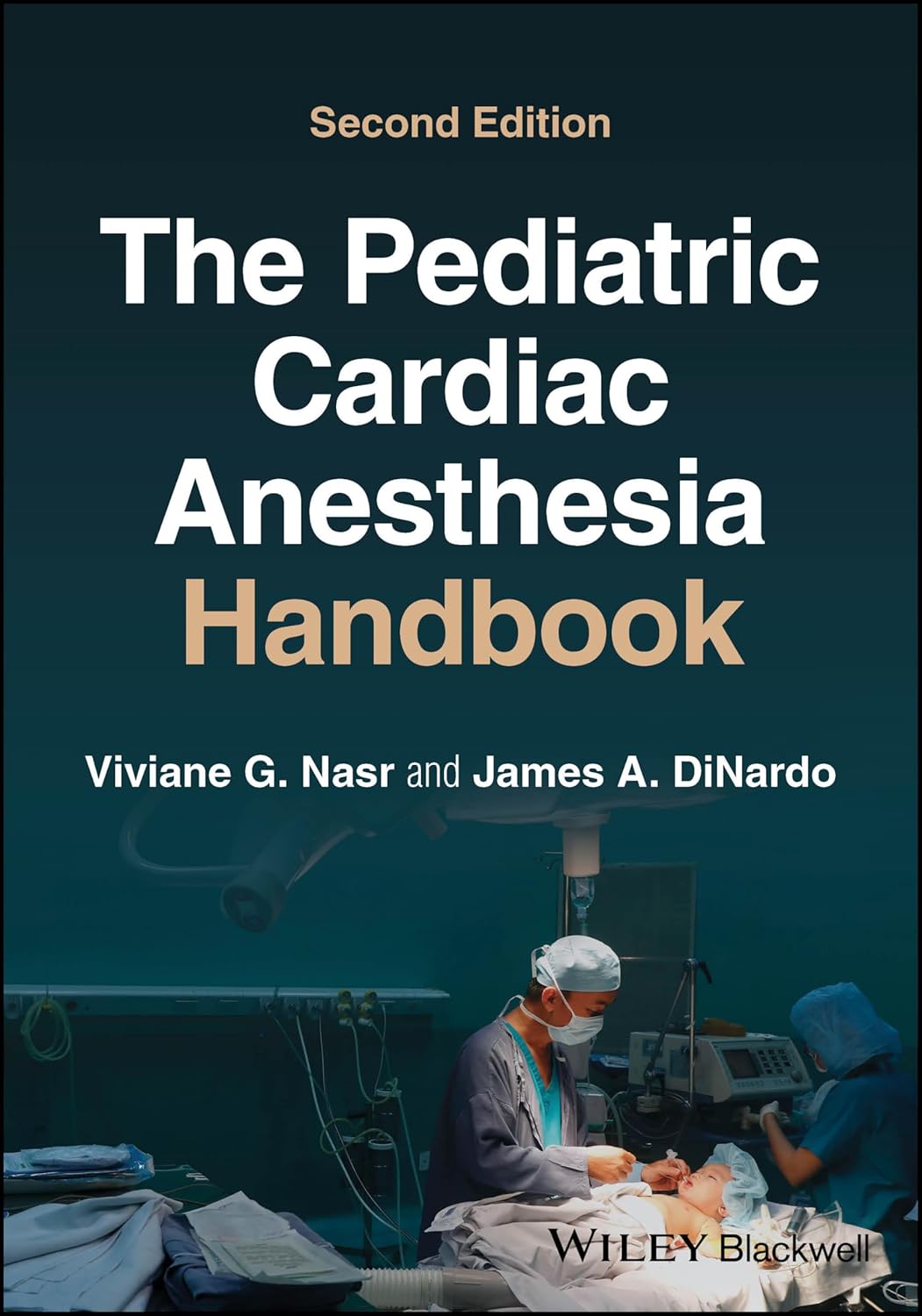
Edition 2 (2025)
Viviane Nasr, James DiNardo
A concise yet comprehensive overview of the anesthetic management of pediatric patients with congenital heart disease
Designed for ease of use, The Pediatric Cardiac Anesthesia Handbook is divided into two parts: Part One covers the basic assessment of patients, including cardiovascular physiology, the pathophysiology of coronary heart disease, preoperative evaluation, intraoperative management, and interpretation of cardiac catheterization data. Part Two contains templated chapters that address a variety of disorders, allowing easy reference to anatomical and physiological features, surgical therapies, anesthetic approach, and postoperative management.
Now in its second edition, The Pediatric Cardiac Anesthesia Handbook contains new chapters on coagulation and blood management, echocardiography, risk scoring systems, and postoperative critical care management, as well as a completely revised chapter on mechanical circulatory support.
Providing clear and reliable, this easily referable pocket-sized resource:
Addresses the additional complexities of pediatric patients and the anesthetic considerations for non-cardiac surgery after heart and heart-lung transplantation
Provides guidelines on specific lesions for the pediatric anesthesiologist caring for cardiac patients presenting for non-cardiac surgery
Contains templated chapters that allow easy reference by members of the multidisciplinary team, such as cardiologists, cardiac intensivists, perfusionists, and surgeons
Features high-quality illustrative echocardiographic images in every chapter and bulleted content designed for rapid reference
Written by an expert author team at the world-renowned Boston Children’s Hospital, The Pediatric Cardiac Anesthesia Handbook is a must-have guide and study aid for anesthesiology and cardiac critical care trainees and practitioners who manage patients with congenital heart disease.
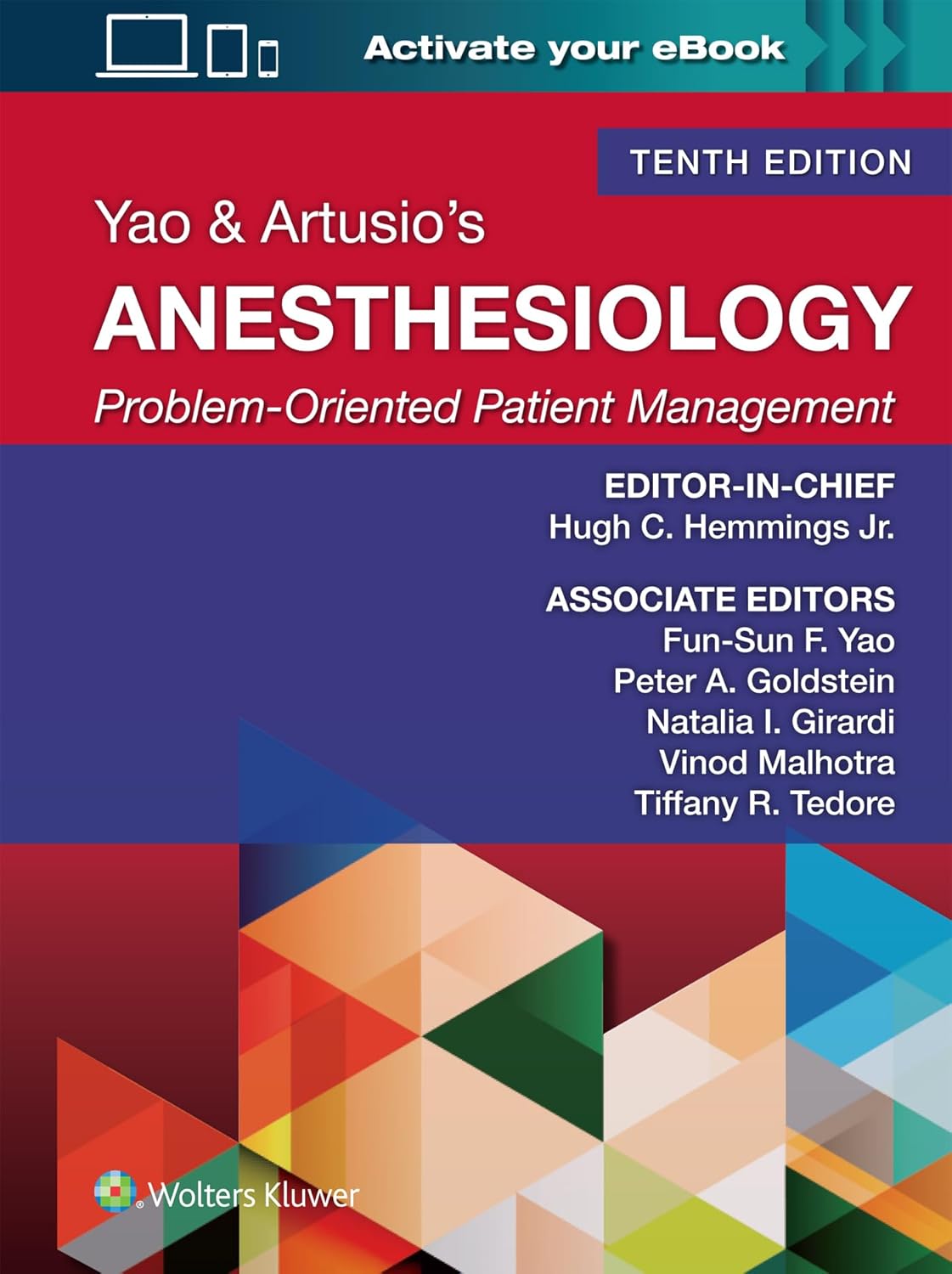
Edition 10 (2025)
Hugh Hemmings, Fun-Sun Yao, Peter Goldstein, Natalia Girardi, Vinod Malhotra, Tiffany Tedore
Prepare for the oral and written boards with this case-based, easy-to-use review tool from Drs. Hugh C. Hemmings Jr., Fun-Sun F. Yao, Peter A. Goldstein, Natalia I. Girardi, Vinod Malhotra, and Tiffany Tedore. Yao & Artusio’s Anesthesiology: Problem-Oriented Patient Management, Tenth Edition, contains more than 60 real-world cases accompanied by questions that conform to the four areas of questioning on the oral boards, reinforcing step-by-step critical thinking about today’s surgical anesthesia and patient management. This core text has been thoroughly revised to bring you up to date with all that’s new in the field.
Features a problem-based approach to emphasize critical thinking, collaborative decision making, and problem-solving skills
Uses a consistent chapter format that includes presentation of a case; questions on medical disease and differential diagnosis, preoperative planning and preparation, intraoperative management, and postoperative management; and complete answers and discussion of the case
Contains new and updated content throughout, including topics such as coagulopathy and major and complex spine surgery, as well as updated references for further study and clarification
Allows you to repeatedly work through key considerations that reinforce logical, critical thinking about patient management

